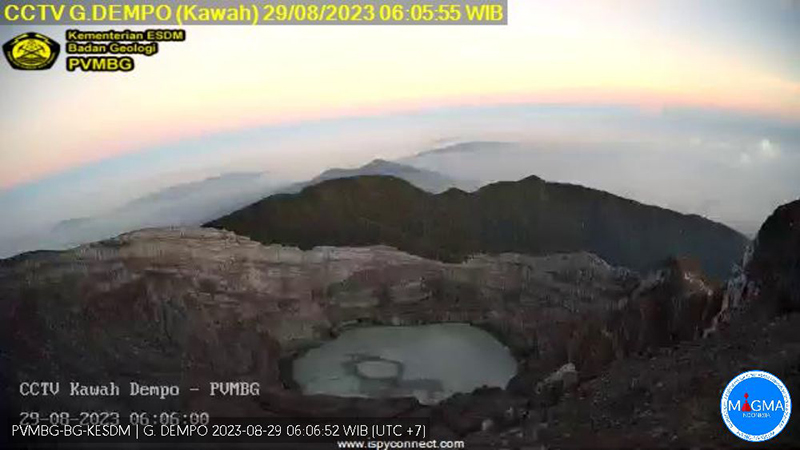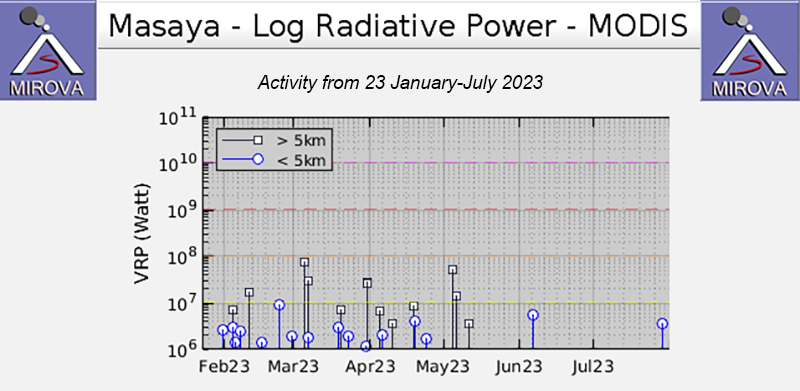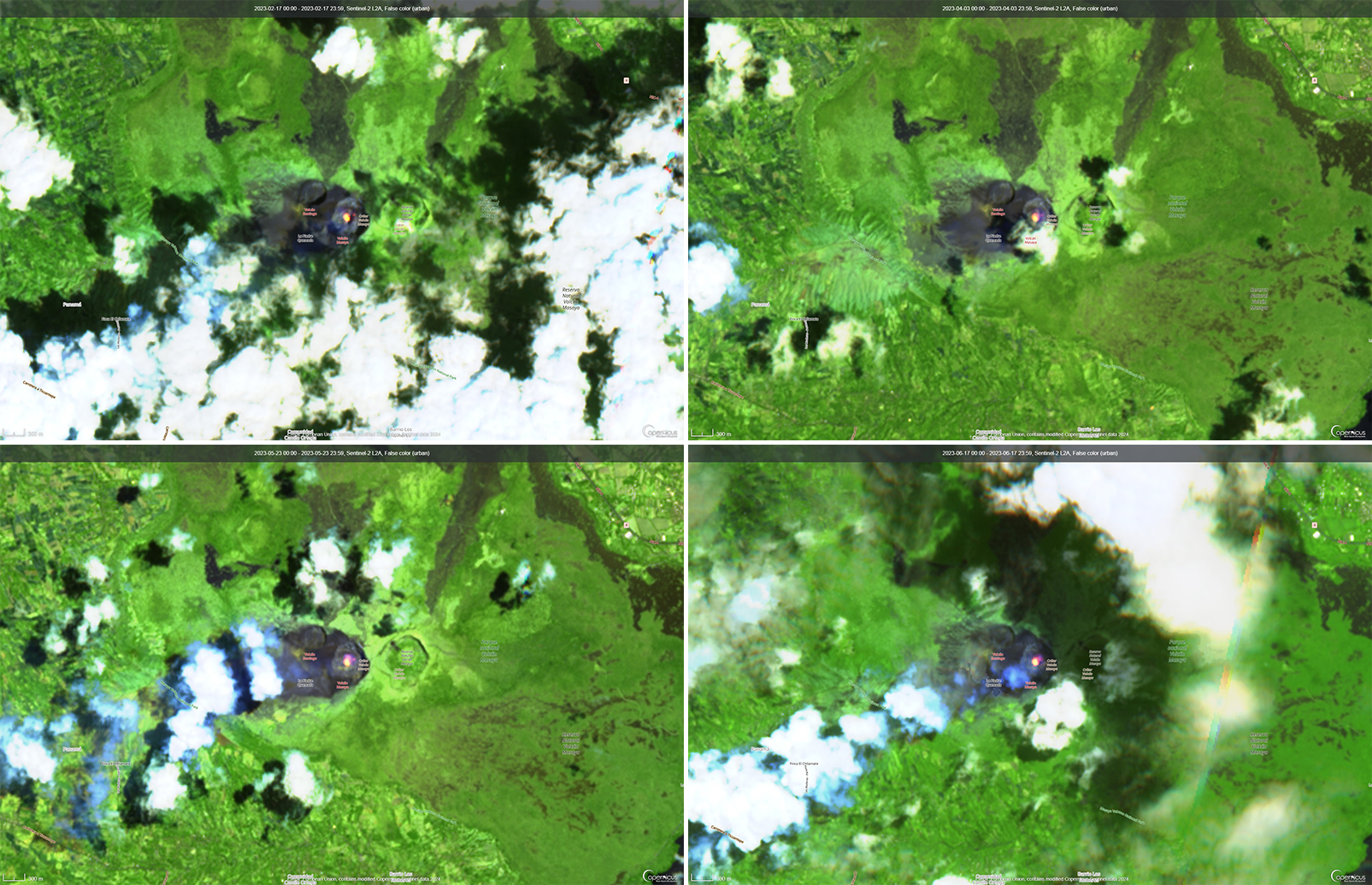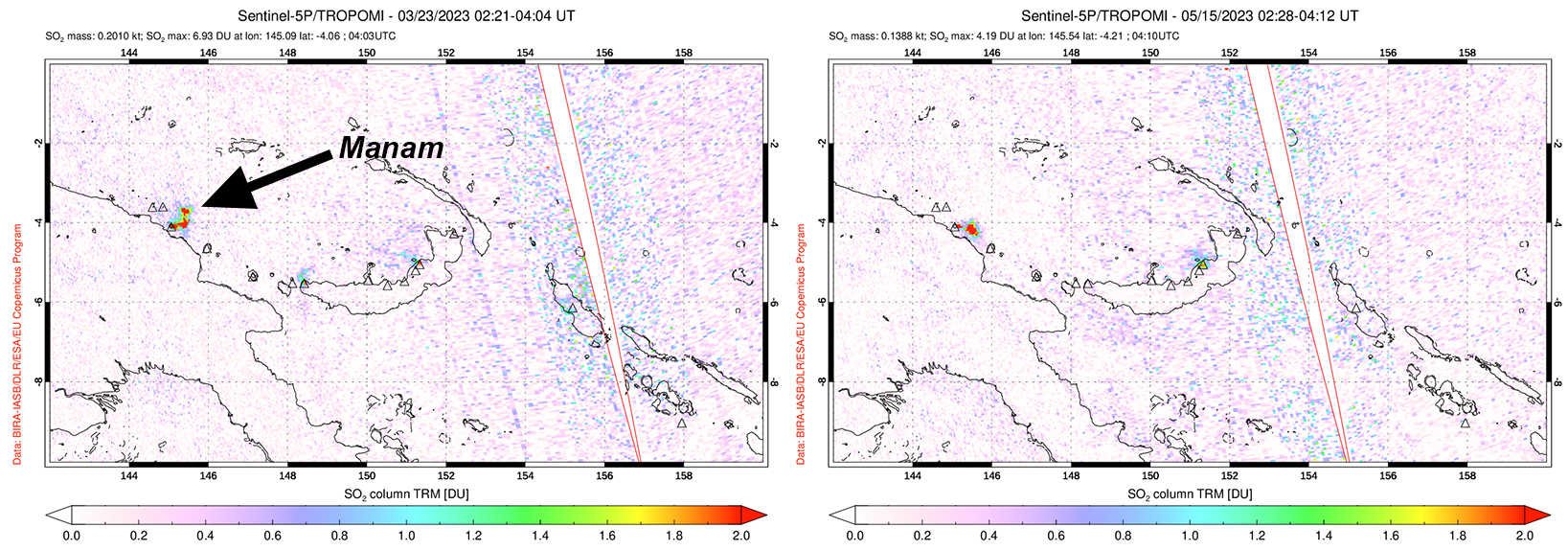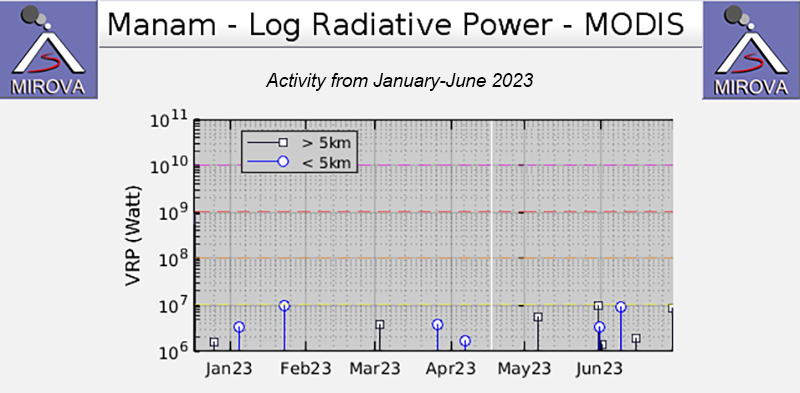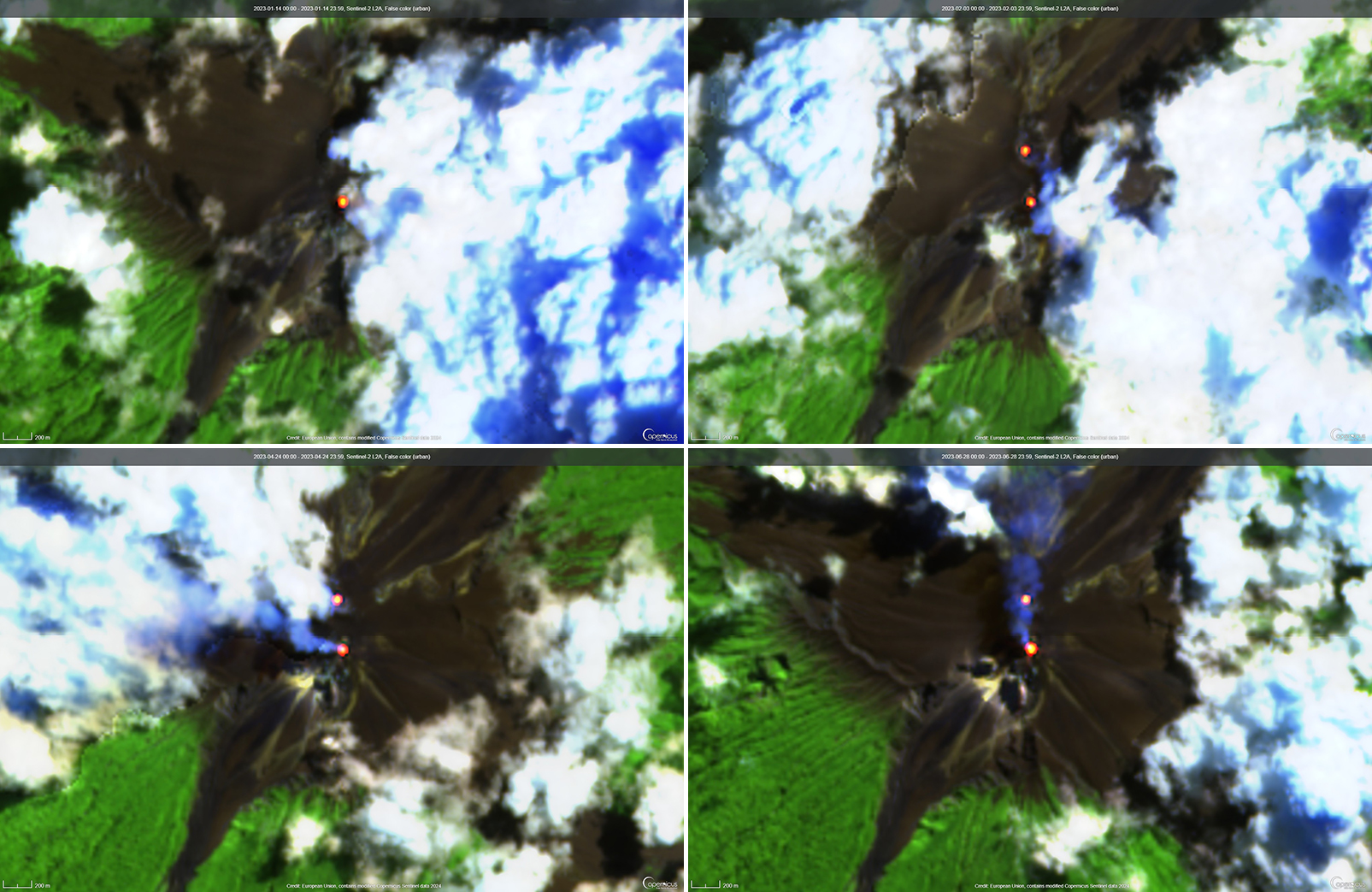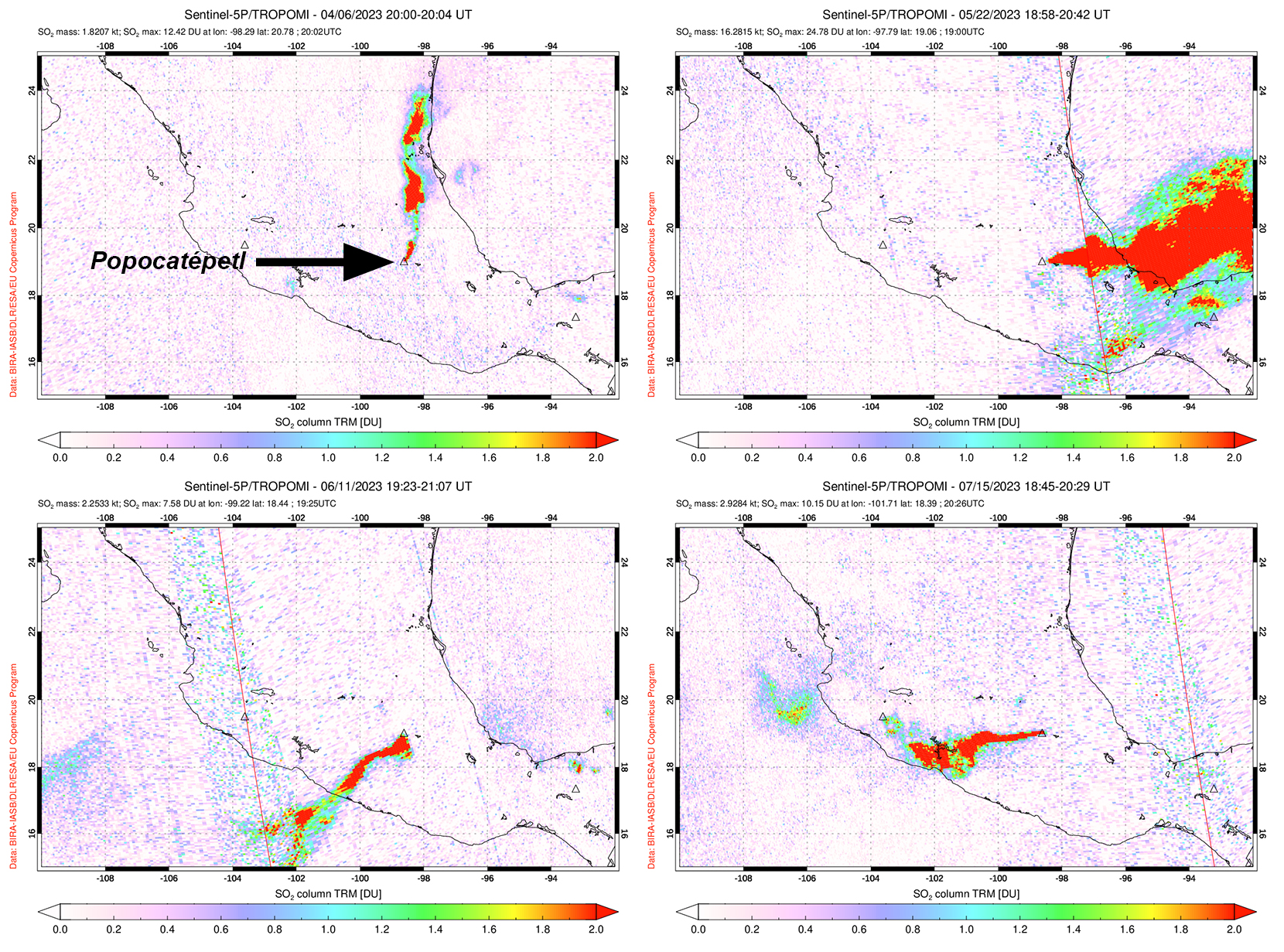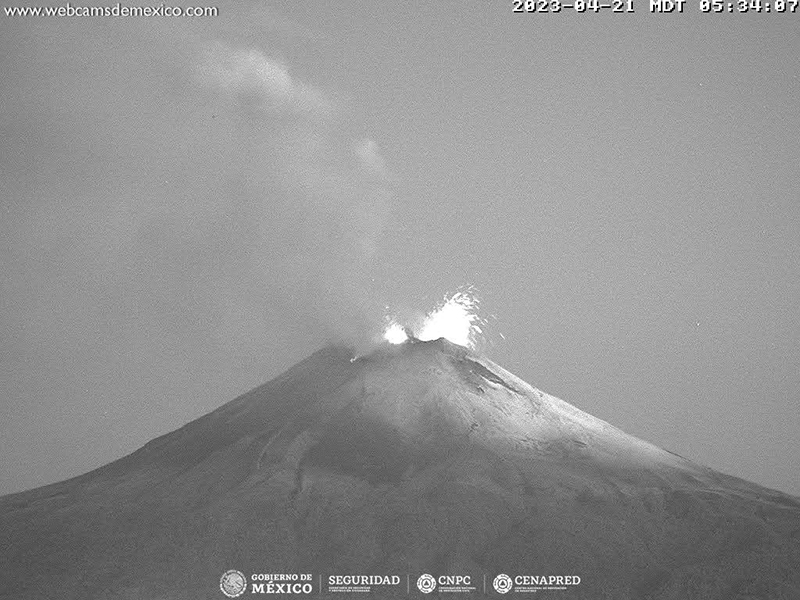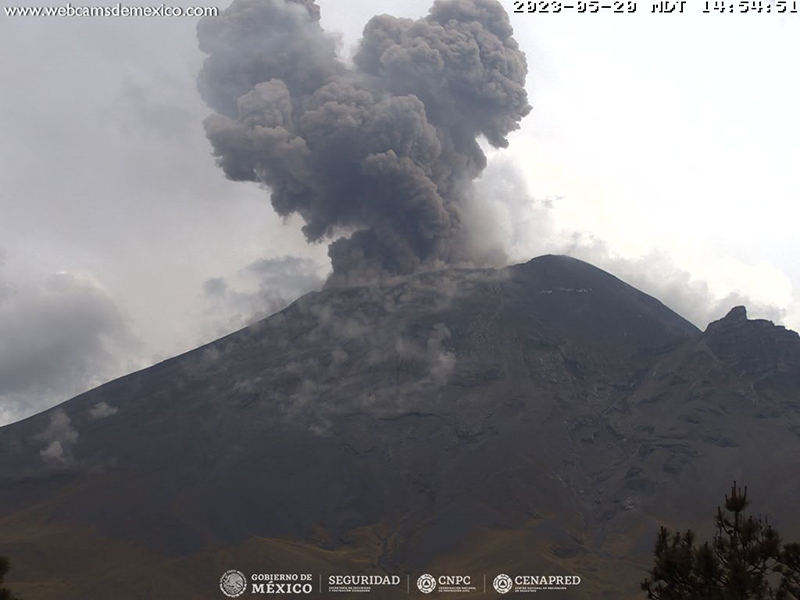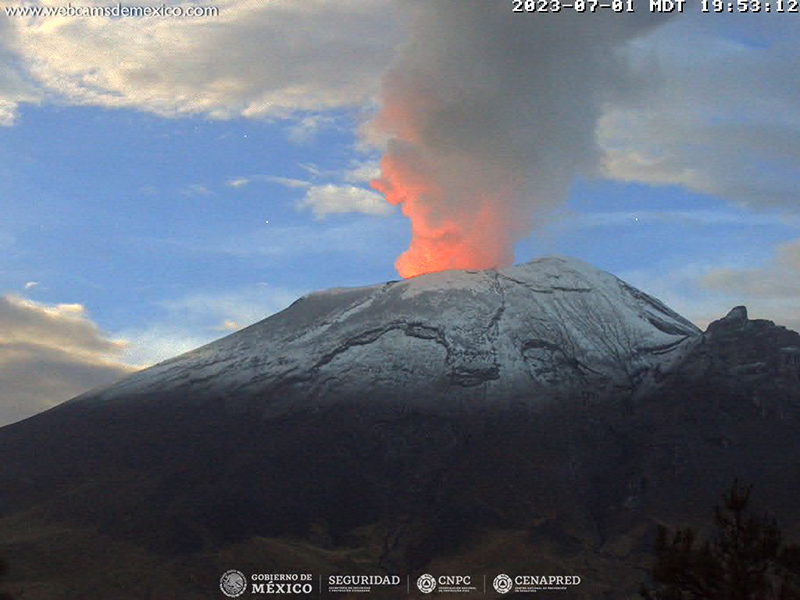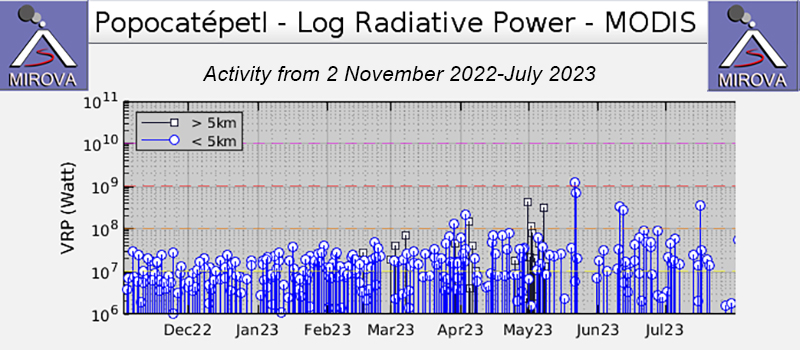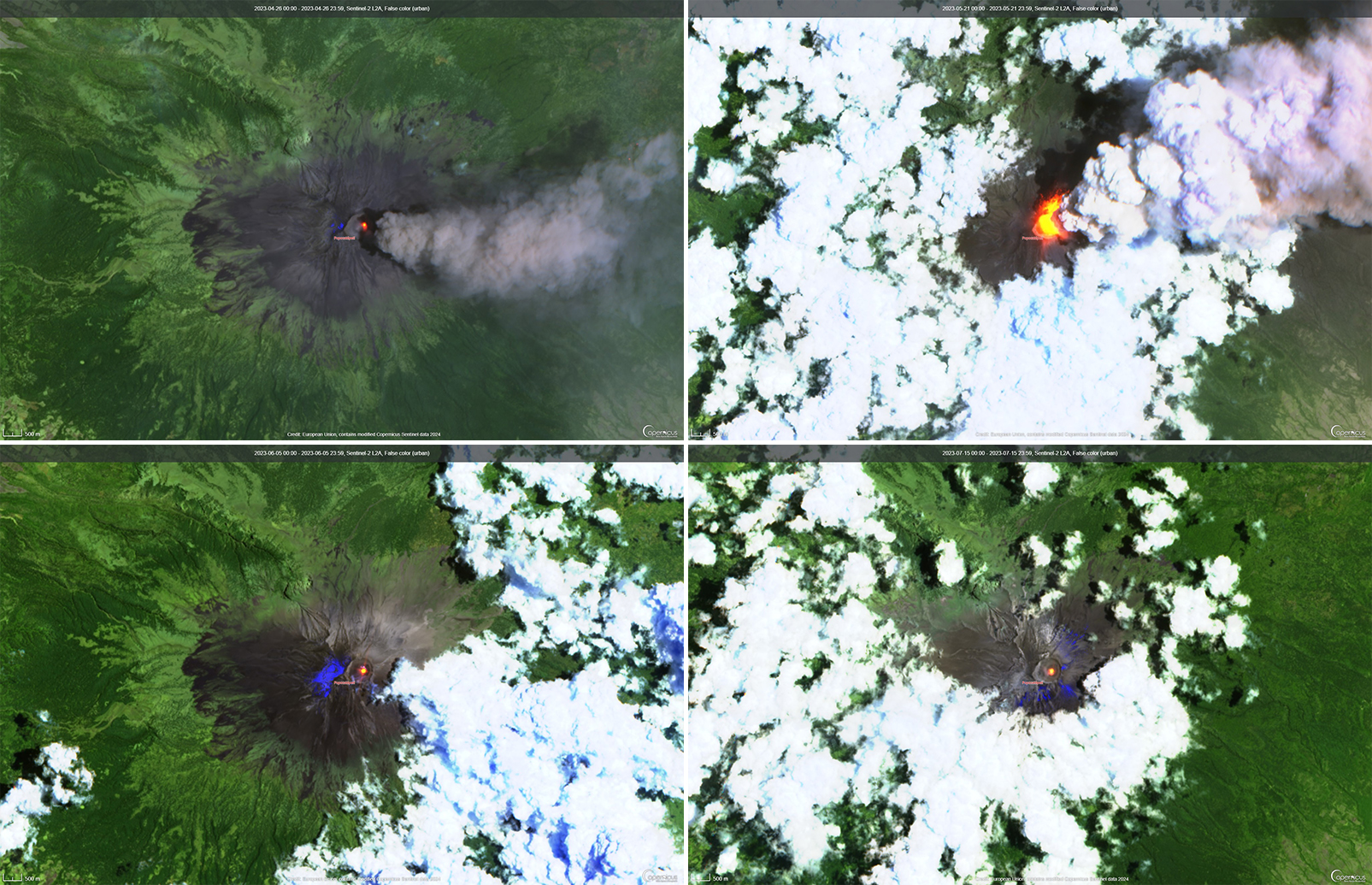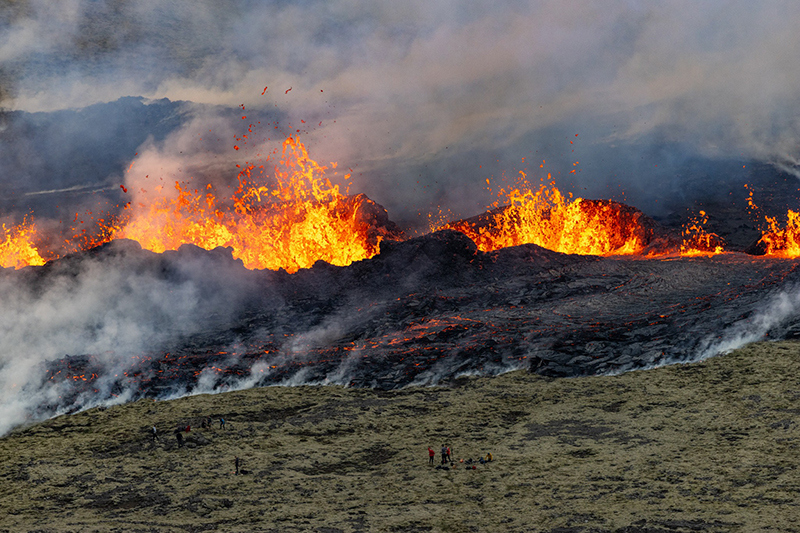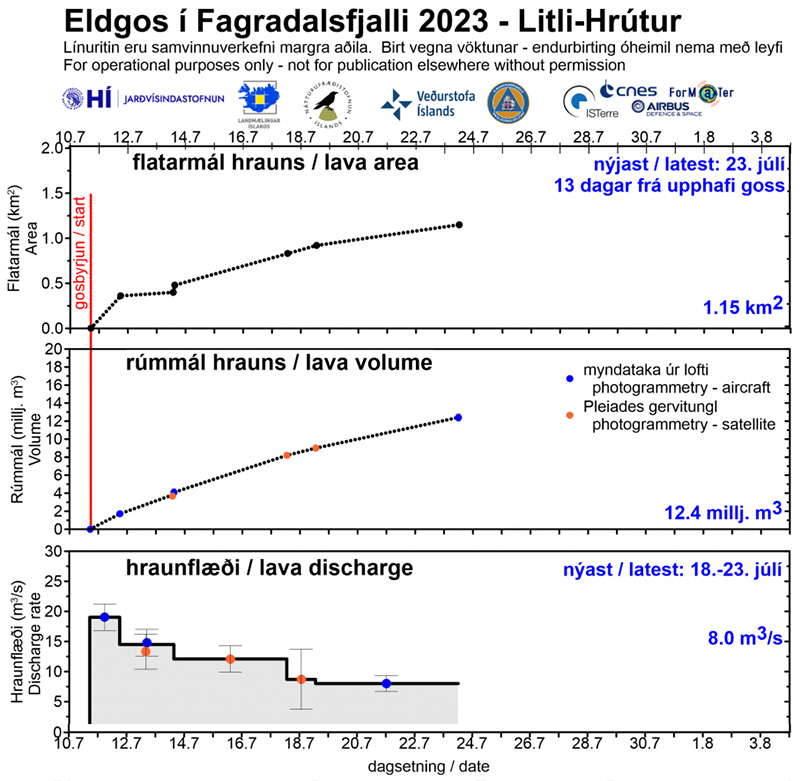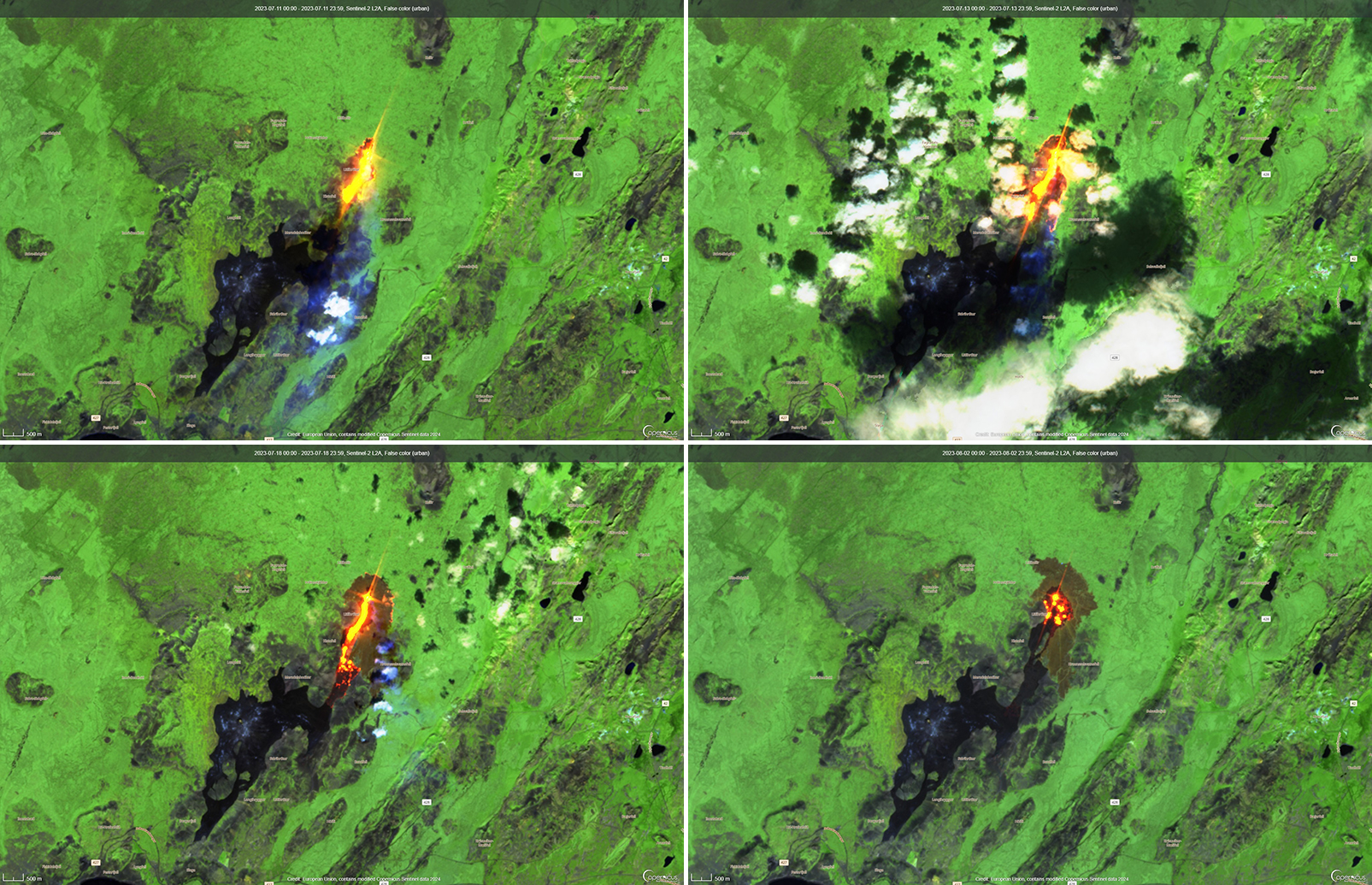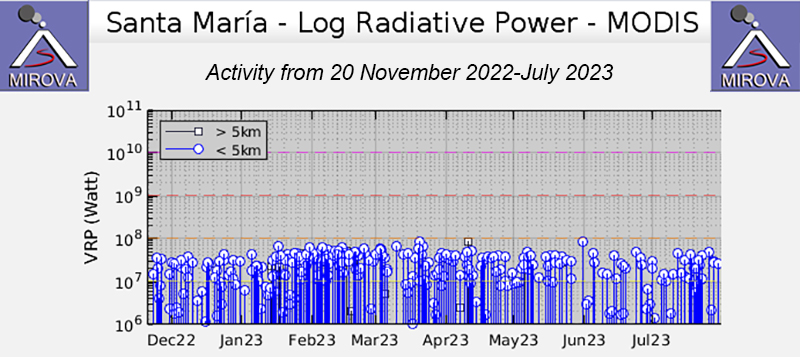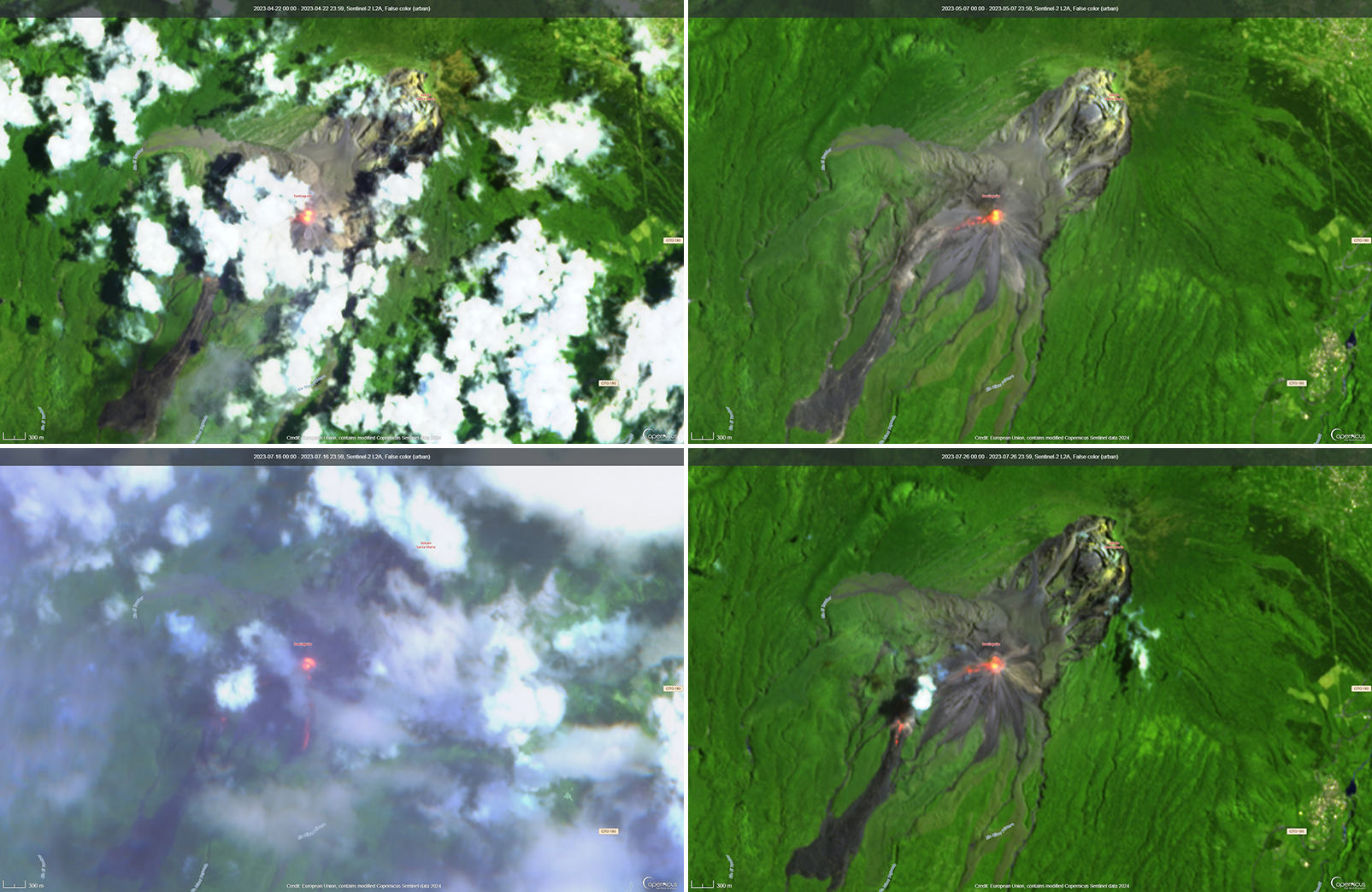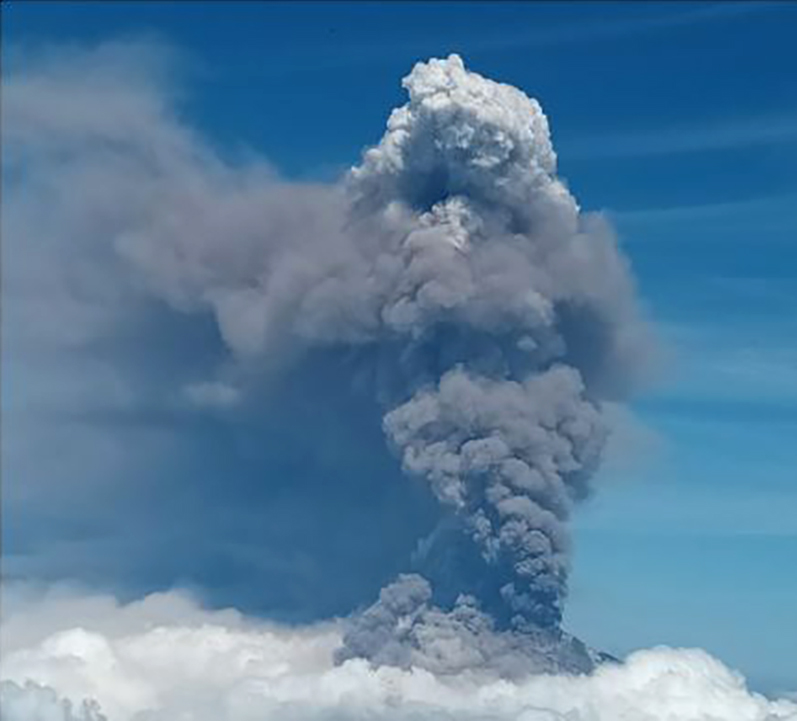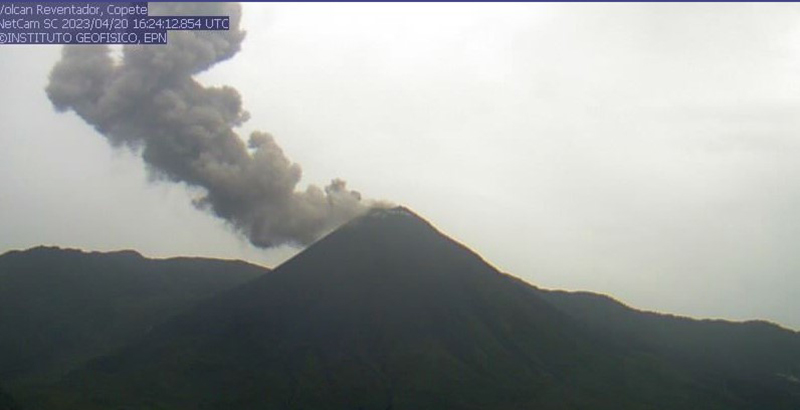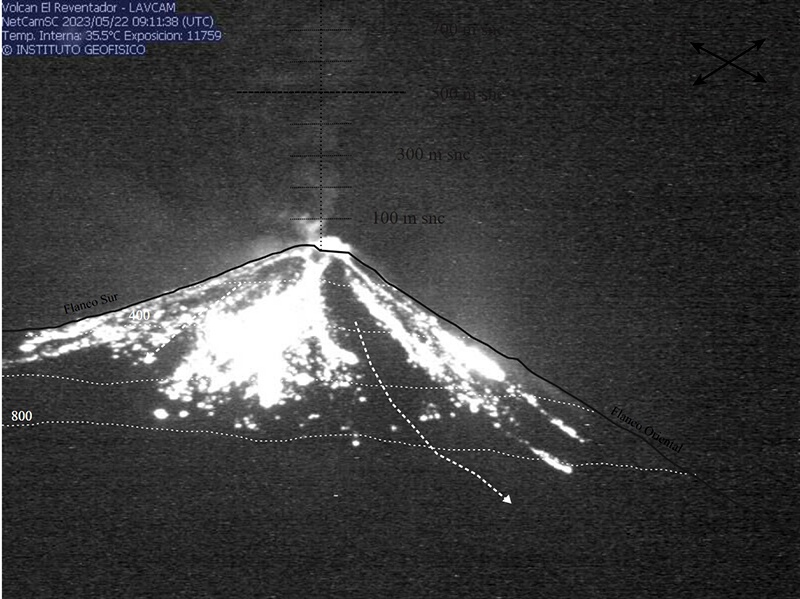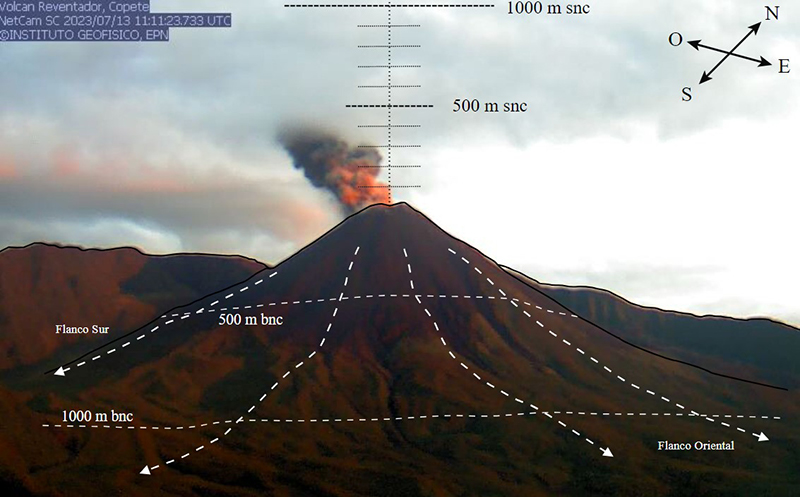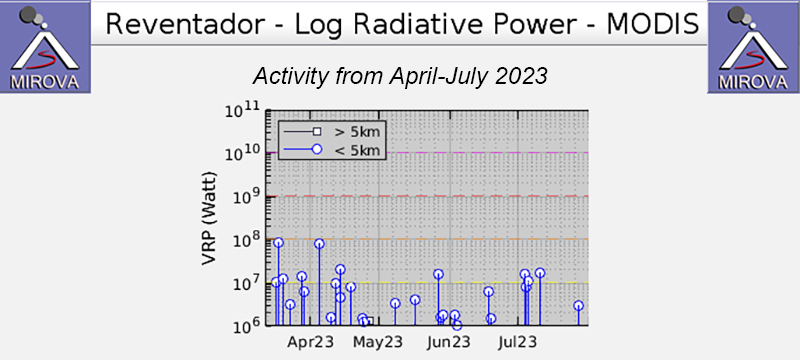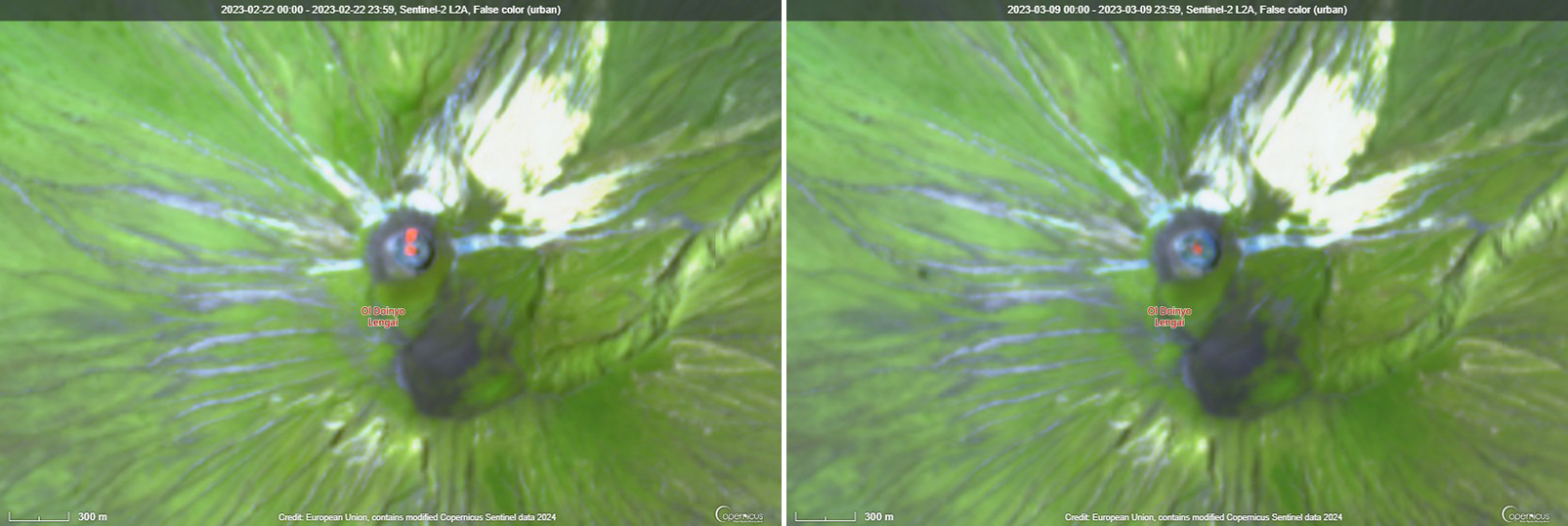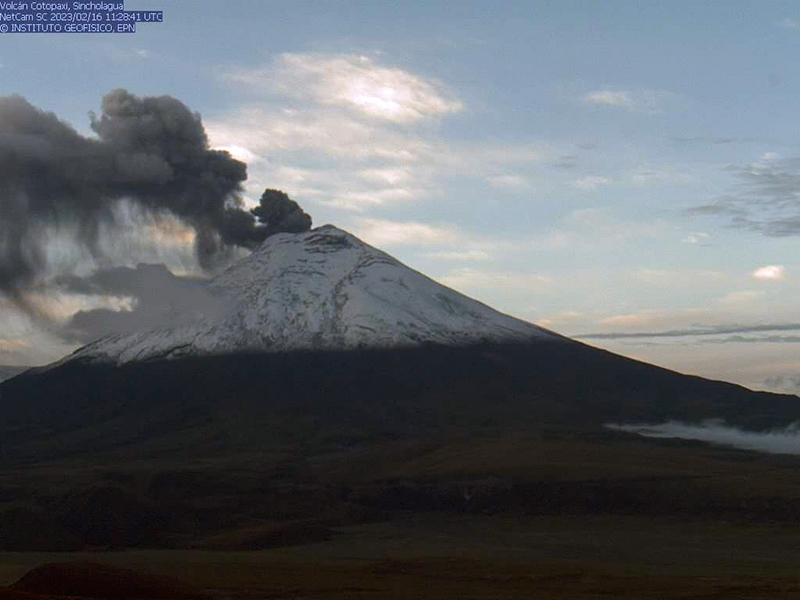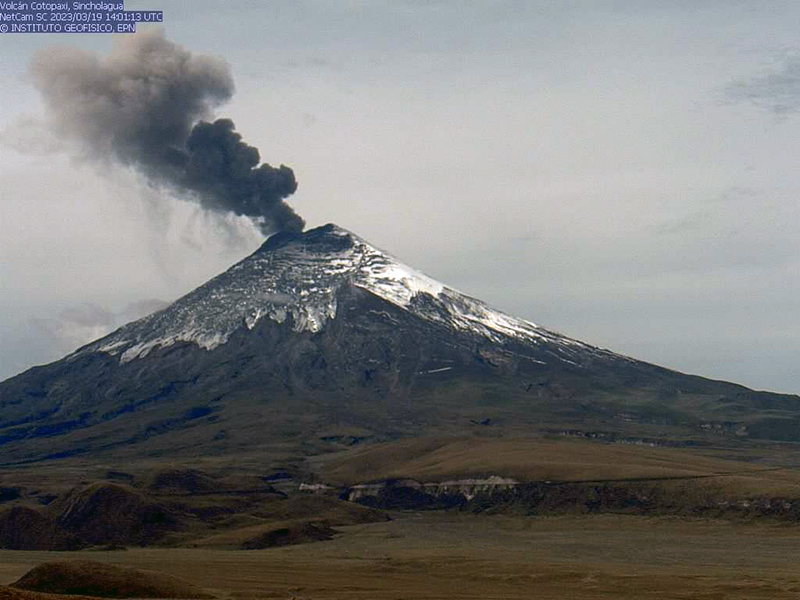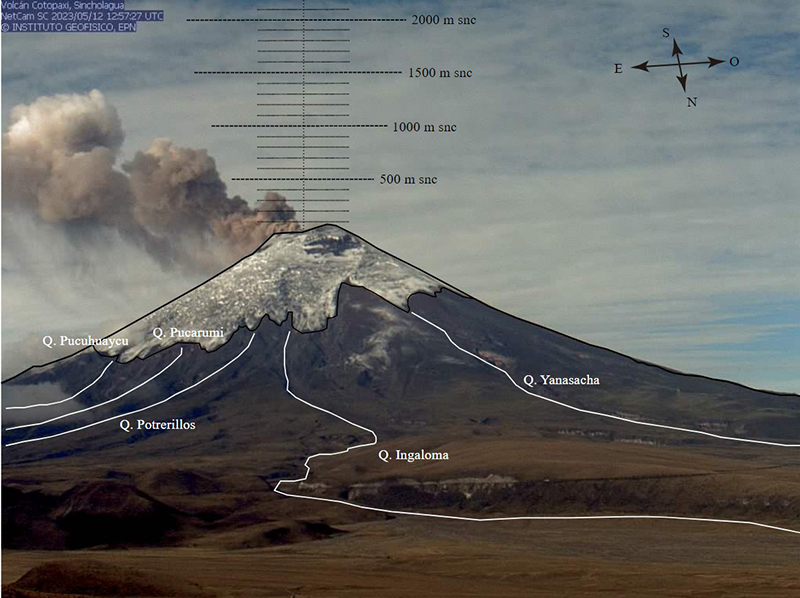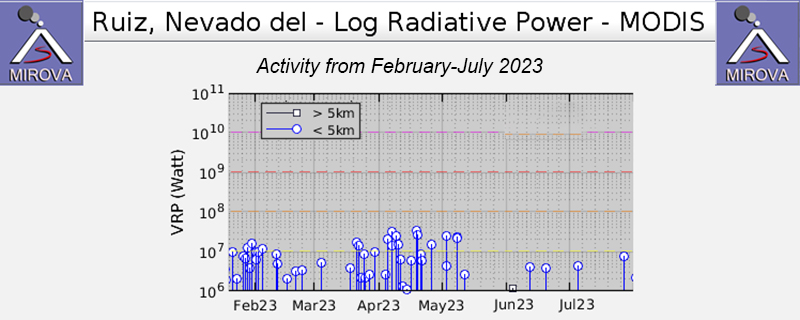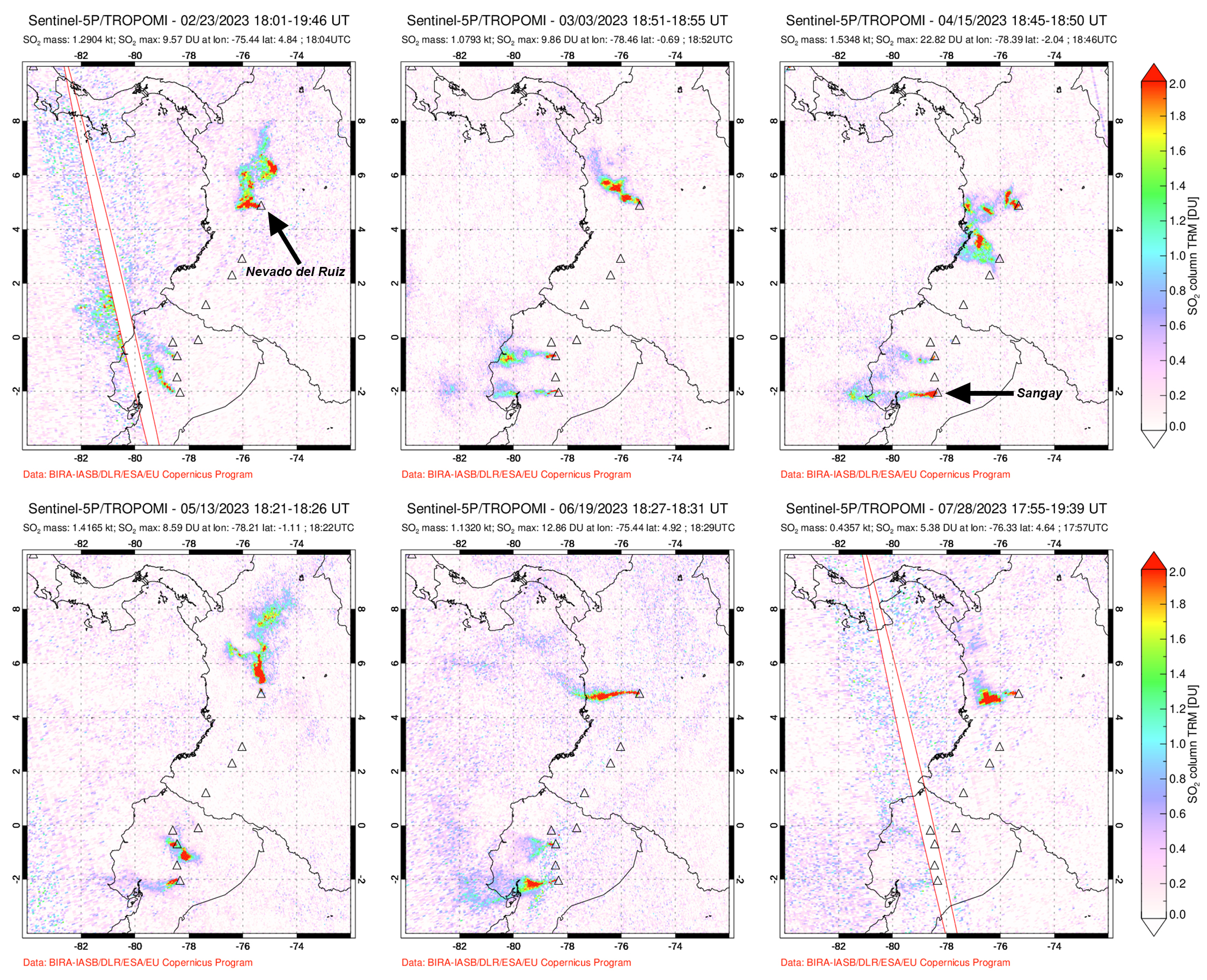Recently Published Bulletin Reports
Nyiragongo (DR Congo) Ongoing lava lake activity in the summit crater through September 2023
Dempo (Indonesia) Weak explosions, some with ash, from the crater lake during July and August 2023
Masaya (Nicaragua) Thermal anomalies in the summit crater during February-July 2023
Manam (Papua New Guinea) Low thermal activity during January-June 2023
Popocatepetl (Mexico) Daily gas-and-ash emissions, ashfall, and explosions during April-July 2023
Fagradalsfjall (Iceland) New eruption consisted of lava flows and fountains during July-August 2023
Santa Maria (Guatemala) Frequent explosions, lava flows, ash plumes, and pyroclastic flows during April-July 2023
Fuego (Guatemala) Daily explosions, ash plumes, ashfall, and pyroclastic flows during April-July 2023
Reventador (Ecuador) Daily explosions, gas-and-ash emissions, and block avalanches persisted during April-July 2023
Ol Doinyo Lengai (Tanzania) Continued thermal activity at the summit crater during February-July 2023
Cotopaxi (Ecuador) Ash emissions, ashfall, and occasional lahars during February-July 2023
Nevado del Ruiz (Colombia) Intermittent gas-and-ash plumes, ashfall events, and seismicity during February-July 2023
Nyiragongo (DR Congo) — October 2023  Cite this Report
Cite this Report
Nyiragongo
DR Congo
1.52°S, 29.25°E; summit elev. 3470 m
All times are local (unless otherwise noted)
Ongoing lava lake activity in the summit crater through September 2023
Nyiragongo is within the Albertine Rift Zone along the western branch of the East African Rift System in the Democratic Republic of the Congo. A lava lake inside the 1.2 km summit crater has been active since at least 1971. Eruptions during the last 120 years have been associated primarily with the summit crater, but several flank lava flows have also been observed as recently as 2019 and 2021, with the latter reaching the city of Goma (15 km S) (BGVN 46:06). Besides lava extrusions, activity has included incandescence, gas and steam emissions, and seismicity. The current report summarizes data between April and September 2023 and is based on occasional communications from the Observatoire Volcanologique de Goma (OVG) and satellite data.
During the reporting period, volcanic activity was relatively low and confined to the persistent lava lake. OVG reported that the eruption continued as normal from 27 May to 11 June, with crater incandescence observed at 1900 on 4 June and 1800 on 10 June. SO2 emissions were low. A subsequent OVG report indicated that activity continued low during 17-24 September. A diffuse sulfur dioxide plume with an estimated mass of 20 tons was identified in satellite data on 25 September.
The MIROVA (Middle InfraRed Observation of Volcanic Activity) hotspot system recorded a surge of moderate to high-power hotspots in about the second week of June 2023, and then frequent hotspots throughout July, and a few scattered hotspots in August. The MODIS-MODVOLC thermal alerts system recorded hotspots only on 3 April, 10 July, and 24, 25, and 27 July (two pixels each day in July). Sentinel-2 satellites recorded lava effusion in the summit crater during the few satellite observation days of the reporting period, corresponding to the elevated thermal observations (figure 97).
Geologic Background. The Nyiragongo stratovolcano contained a lava lake in its deep summit crater that was active for half a century before draining catastrophically through its outer flanks in 1977. The steep slopes contrast to the low profile of its neighboring shield volcano, Nyamuragira. Benches in the steep-walled, 1.2-km-wide summit crater mark levels of former lava lakes, which have been observed since the late-19th century. Two older stratovolcanoes, Baruta and Shaheru, are partially overlapped by Nyiragongo on the north and south. About 100 cones are located primarily along radial fissures south of Shaheru, east of the summit, and along a NE-SW zone extending as far as Lake Kivu. Many cones are buried by voluminous lava flows that extend long distances down the flanks, which is characterized by the eruption of foiditic rocks. The extremely fluid 1977 lava flows caused many fatalities, as did lava flows that inundated portions of the major city of Goma in January 2002.
Information Contacts: Observatoire Volcanologique de Goma (OVG), Departement de Geophysique, Centre de Recherche en Sciences Naturelles, Lwiro, D.S. Bukavu, DR Congo; MIROVA (Middle InfraRed Observation of Volcanic Activity), a collaborative project between the Universities of Turin and Florence (Italy) supported by the Centre for Volcanic Risk of the Italian Civil Protection Department (URL: http://www.mirovaweb.it/); Hawai'i Institute of Geophysics and Planetology (HIGP) - MODVOLC Thermal Alerts System, School of Ocean and Earth Science and Technology (SOEST), Univ. of Hawai'i, 2525 Correa Road, Honolulu, HI 96822, USA (URL: http://modis.higp.hawaii.edu/); Copernicus Browser, Copernicus Data Space Ecosystem, European Space Agency (URL: https://dataspace.copernicus.eu/browser/).
Dempo (Indonesia) — September 2023  Cite this Report
Cite this Report
Dempo
Indonesia
4.016°S, 103.121°E; summit elev. 3142 m
All times are local (unless otherwise noted)
Weak explosions, some with ash, from the crater lake during July and August 2023
The Dempo stratovolcano in SE Sumatra, Indonesia, has had many small explosions reported since 1817. The active crater contains a 400-m-wide lake was the source of phreatic explosions in 2006, 2009, 2017, and most recently in May 2022. This report covers activity from June 2022 to December 2023, based on daily and special reports of the Pusat Vulkanologi dan Mitigasi Bencana Geologi (PVMBG), and satellite data. Throughout the reporting period, the Alert Level remained at 2 (on a scale of 1-4), and the public were reminded to stay 1 km away from the crater and as far as 2 km on the N flank.
PVMBG reported that at 2115 on 25 July 2023, an explosion produced a white-and-gray ash plume that rose at least 2 km above the summit and drifted S and SW. Additional ash explosions were recorded at 1547 and 2215 on 26 July, the latter rising 2 km above the summit crater and drifting S and SW, based on ground observations. Another explosion was reported by PVMBG at 2105 on 21 August, but no ash emissions were observed. Webcam images posted in daily MAGMA Indonesia reports showed possible patches of discolored water or material floating on the surface of the crater lake during 27-29 August (figure 8).
Most Sentinel-2 satellite views of Dempo during the reporting period were obscured by weather clouds. When observations were possible, the crater lake surface typically looked milky gray, indicating high levels of particulate matter. However, during several days in March and April 2023 the lake took on a blue appearance.
Geologic Background. Dempo is a stratovolcano that rises above the Pasumah Plain of SE Sumatra. The andesitic complex has two main peaks, Gunung Dempo and Gunung Marapi, constructed near the SE rim of a 3-km-wide amphitheater open to the north. The high point of the older Gunung Dempo crater rim is slightly lower, and lies at the SE end of the summit complex. The taller Marapi cone was constructed within the older crater. Remnants of seven craters are found at or near the summit, with volcanism migrating WNW over time. The active 750 x 1,100 m active crater cuts the NW side of the Marapi cone and contains a 400-m-wide lake at the far NW end. Eruptions recorded since 1817 have been small-to-moderate explosions that produced local ashfall.
Information Contacts: Pusat Vulkanologi dan Mitigasi Bencana Geologi (PVMBG, also known as Indonesian Center for Volcanology and Geological Hazard Mitigation, CVGHM), Jalan Diponegoro 57, Bandung 40122, Indonesia (URL: http://www.vsi.esdm.go.id/); MAGMA Indonesia, Kementerian Energi dan Sumber Daya Mineral (URL: https://magma.esdm.go.id/v1); Copernicus Browser (URL: https://dataspace.copernicus.eu/browser).
Masaya (Nicaragua) — August 2023  Cite this Report
Cite this Report
Masaya
Nicaragua
11.9844°N, 86.1688°W; summit elev. 594 m
All times are local (unless otherwise noted)
Thermal anomalies in the summit crater during February-July 2023
Masaya, located about 20 km SE of Managua, the capital Nicaragua, is a broad, 6 x 11 km caldera with steep-sided walls up to 300 m high. The caldera is filled on its NW end by more than a dozen vents that erupted along a circular, 4-km-diameter fracture system. Eruptions have originated from the Nindirí and Masaya cones, which were constructed at the southern end of the fracture system and contain multiple summit craters, including the currently active Santiago crater. The Santiago crater contains a small lava lake that emits weak gas-and-steam plumes. The current eruption period began in October 2015 and more recently has been characterized by thermal activity in the summit crater (BGVN 48:03). This report covers similar activity from February through July 2023, consisting of continuing thermal activity and sulfur dioxide emissions, according to monthly reports from Instituto Nicaragüense de Estudios Territoriales (INETER) and satellite data.
Thermal activity has remained relatively consistent, according to a MIROVA (Middle InfraRed Observation of Volcanic Activity) analysis of MODIS satellite data, which showed occasional low-power thermal anomalies during the reporting period. There were six anomalies were detected during February, four during March, three during April, one during early June, and one during late July (figure 109). Infrared satellite imagery showed occasional hotspots in the Santiago crater’s lava lake throughout the reporting period (figure 110). The TROPOMI instrument on the Sentinel-5P satellite detected weak and small sulfur dioxide plumes that drifted generally W and SW on 8-9 February, 3-4, 13, and 18 March, 25 and 30 April, 11-12 May, 1-2 and 11 June, and 3 July.
Activity was relatively low throughout the reporting period. Seismic tremor was at 60 RSAM units during February and March. On 10 February FLIR temperature of the lava lake was measured from Santiago crater, recording values of 290°C, which was within the typical range of 200-500°C. INETER noted that the level of the lava lake had decreased compared to previous observations made during October 2022. On 15 March gas measurements were made with a Mobile DOAS technique, showing average sulfur dioxide values of 1,448 tons/day (t/d); the previous date that measurements were taken was on 14 November 2022 with a value of 1,222 t/d. On 25 April sulfur dioxide measurements decreased slightly to an average of 1,042 t/d. Temperature values of the lava lake from Santiago crater were 254°C on 26 April.
Seismic tremor was at 50 RSAM units during May and consisted of one volcano-tectonic (VT) event and 347 low-frequency (LF) events. On 5 May INETER recorded a temperature of the lava lake from Santiago crater of 270°C and reported that the level of the lava lake was lower compared to previous observations made in April. Sulfur dioxide measurements taken on 15 May were 1,438 t/d. During June and July, seismic tremor was maintained at 50 RSAM units and included one VT event and 221 LP-type events during June, and three LP-type events during July. On 28 June measurements of the lava lake had increased slightly to 315°C and the level of the lava lake continued to decrease. The average values of released sulfur dioxide emissions were 1,056 t/d on 19 June and 1,012 t/d on 14 July.
Geologic Background. Masaya volcano in Nicaragua has erupted frequently since the time of the Spanish Conquistadors, when an active lava lake prompted attempts to extract the volcano's molten "gold" until it was found to be basalt rock upon cooling. It lies within the massive Pleistocene Las Sierras caldera and is itself a broad, 6 x 11 km basaltic caldera with steep-sided walls up to 300 m high. The caldera is filled on its NW end by more than a dozen vents that erupted along a circular, 4-km-diameter fracture system. The Nindirí and Masaya cones, the source of observed eruptions, were constructed at the southern end of the fracture system and contain multiple summit craters, including the currently active Santiago crater. A major basaltic Plinian tephra erupted from Masaya about 6,500 years ago. Recent lava flows cover much of the caldera floor and there is a lake at the far eastern end. A lava flow from the 1670 eruption overtopped the north caldera rim. Periods of long-term vigorous gas emission at roughly quarter-century intervals have caused health hazards and crop damage.
Information Contacts: Instituto Nicaragüense de Estudios Territoriales (INETER), Apartado Postal 2110, Managua, Nicaragua (URL: http://www.ineter.gob.ni/); MIROVA (Middle InfraRed Observation of Volcanic Activity), a collaborative project between the Universities of Turin and Florence (Italy) supported by the Centre for Volcanic Risk of the Italian Civil Protection Department (URL: http://www.mirovaweb.it/); NASA Global Sulfur Dioxide Monitoring Page, Atmospheric Chemistry and Dynamics Laboratory, NASA Goddard Space Flight Center (NASA/GSFC), 8800 Greenbelt Road, Goddard, Maryland, USA (URL: https://so2.gsfc.nasa.gov/); Copernicus Browser, Copernicus Data Space Ecosystem, European Space Agency (URL: https://dataspace.copernicus.eu/browser/).
Manam (Papua New Guinea) — September 2023  Cite this Report
Cite this Report
Manam
Papua New Guinea
4.08°S, 145.037°E; summit elev. 1807 m
All times are local (unless otherwise noted)
Low thermal activity during January-June 2023
Manam is a 10-km-wide island that consists of two active summit craters: the Main summit crater and the South summit crater and is located 13 km off the northern coast of mainland Papua New Guinea. Frequent mild-to-moderate eruptions have been recorded since 1616. The current eruption period began during June 2014 and has more recently consisted of ash plumes and thermal activity (BGVN 48:07). This report covers activity during January through June 2023 primarily using various satellite data.
Weak and intermittent sulfur dioxide plumes were detected using the TROPOMI instrument on the Sentinel-5P satellite, some of which exceeded at least two Dobson Units (DU) and drifted in different directions (figure 96). Few low-power thermal anomalies were recorded by the MIROVA (Middle InfraRed Observation of Volcanic Activity) system; two anomalies were captured during January, one during late March, one during early April, one during late May, and one during early June (figure 97). On clear weather days, thermal activity was captured in infrared satellite images in both the Main and South summit craters (figure 98).
Geologic Background. The 10-km-wide island of Manam, lying 13 km off the northern coast of mainland Papua New Guinea, is one of the country's most active volcanoes. Four large radial valleys extend from the unvegetated summit of the conical basaltic-andesitic stratovolcano to its lower flanks. These valleys channel lava flows and pyroclastic avalanches that have sometimes reached the coast. Five small satellitic centers are located near the island's shoreline on the northern, southern, and western sides. Two summit craters are present; both are active, although most observed eruptions have originated from the southern crater, concentrating eruptive products during much of the past century into the SE valley. Frequent eruptions, typically of mild-to-moderate scale, have been recorded since 1616. Occasional larger eruptions have produced pyroclastic flows and lava flows that reached flat-lying coastal areas and entered the sea, sometimes impacting populated areas.
Information Contacts: MIROVA (Middle InfraRed Observation of Volcanic Activity), a collaborative project between the Universities of Turin and Florence (Italy) supported by the Centre for Volcanic Risk of the Italian Civil Protection Department (URL: http://www.mirovaweb.it/); NASA Global Sulfur Dioxide Monitoring Page, Atmospheric Chemistry and Dynamics Laboratory, NASA Goddard Space Flight Center (NASA/GSFC), 8800 Greenbelt Road, Goddard, Maryland, USA (URL: https://so2.gsfc.nasa.gov/); Copernicus Browser, Copernicus Data Space Ecosystem, European Space Agency (URL: https://dataspace.copernicus.eu/browser/).
Popocatepetl (Mexico) — September 2023  Cite this Report
Cite this Report
Popocatepetl
Mexico
19.023°N, 98.622°W; summit elev. 5393 m
All times are local (unless otherwise noted)
Daily gas-and-ash emissions, ashfall, and explosions during April-July 2023
Popocatépetl, located 70 km SE of Mexico City, Mexico, contains a 400 x 600 m-wide summit crater. Records of activity date back to the 14th century; three major Plinian eruptions, the most recent of which took place about 800 CE, have occurred since the mid-Holocene, accompanied by pyroclastic flows and voluminous lahars that swept basins below the volcano. The current eruption period began in January 2005, characterized by numerous episodes of lava dome growth and destruction within the summit crater. Recent activity has consisted of daily gas-and-ash emissions, explosions, and ashfall (BGVN 48:04). This report updates activity during April through July 2023, which consisted of similar activity, according to daily reports from México's Centro Nacional de Prevención de Desastres (CENAPRED) and various satellite data.
Daily gas-and-steam emissions, containing some amount of ash, persisted during April through July 2023. CENAPRED reported the number of low-intensity gas-and-ash emissions or “exhalations” and the minutes of tremor, which sometimes included harmonic tremor in their daily reports (figure 213). A total of 36 volcano-tectonic (VT) tremors were detected throughout the reporting period. The average number of exhalations was 104 per day, with a maximum number of 315 on 31 May 2023. Frequent sulfur dioxide plumes that exceeded two Dobson Units (DU) and drifted in multiple directions were visible in satellite data from the TROPOMI instrument on the Sentinel-5P satellite (figure 214).
Activity during April consisted of gas-and-steam and ash emissions, with 139 explosions and six VT-type events detected. An average number of 169 exhalations occurred each day, which mostly consisted of water vapor, volcanic gases, and a small amount of ash. On most days, webcam images showed nighttime crater incandescence and incandescent material that was deposited on the upper flanks. Two large explosions at 0256 and 0342 on 3 April ejected material 2.4 km from the crater. Light ashfall was reported in Amecameca (20 km NW). On 12 April at 0353 a moderate explosion ejected material 1.5-2 km onto the S flank. Light ashfall was reported in Tochimilco (16 km SSE) and Atlixco (25 km SE) on 20 April and in Atlautla (16 km W), Tlalmanalco (27 km NW), San Pedro Benito Juárez and Atlixco on 21 April. Explosions at 0533 (figure 215) and 0559 on 21 April ejected incandescent material on the slopes as far as 2.3 km N from the crater. A moderate explosion at 0109 on 26 April ejected material on the N flank 1 km from the crater and at 0116 on 27 April ejected incandescent material was deposited onto the upper flanks. According to the Washington VAAC, ash plumes identified in daily satellite images rose to 5.8-7.3 km altitude and drifted NE, E, and SE.
During May there was an average of 131 exhalations each day, and a monthly total of 5 VT-type events, and 123 explosions, 85 of which were minor explosions and 37 were described as moderate. According to the Washington VAAC, daily ash plumes were identified in satellite images that rose to 6.1-7.3 km altitude and drifted E and SE. The National Center for Communications and Civil Protection Operations (CENACOM) reported light ashfall in Ozumba (18 km W), Tlalmanalco, and Temamatla (33 km NW) on 5 May and in Amecameca, Ayapango (24 km WNW), Temamatla, Tenango del Aire (29 km NW), Tlalmanalco, Tepetlixpa (20 km W), and Cocotitlán (34 km NW) on 6 May; moderate ashfall was reported in Tlalmanalco and Tenango del Aire. On 15 May light ashfall was reported in Puebla (43 km E) and Atlixco and moderate ashfall was reported in areas S of the volcano. CENAPRED reported that activity intensified during mid-May after the formation of small-to-medium lava domes on the summit crater floor, followed by their destruction. Periods of high-frequency tremor lasted more than 12 hours during 16-17 May and more than 10 hours during 17-18 May.
During the morning of 17 May CENACOM reported light ashfall in Puebla, Atlixco, Cholula (35 km E), and San Martín Texmelucan (35 km NE) and in Atlixco and Cholula during the morning of 18 May. Light ashfall was reported in Tétela del Volcán (20 km SW) during the morning of 19 May. A period of high-frequency tremor began around 1800 on 19 May and lasted roughly 10 hours until about 0400 on 20 May and was accompanied by gas-and-steam and ash plumes that drifted NNW. Continuous incandescent ejecta was deposited onto the flanks as far as 1.5 km from the crater.
According to CENACOM on 20 May the Benito Juárez International Airport closed during 04300-1000 and the Felipe Ángeles International Airport closed during 0600-1100 so that ash could be cleared from the runways. Ash was deposited in multiple areas downwind including in the municipalities: Tétela del Volcán, Venustiano Carranza (66 km NW), Gustavo A. Madero (73 km NW), Azcapotzalco (78 km NW), Tlalpan (62 km NW), Iztapalapa (58 km NW), Zumpango, Tlalmanalco, Ecatepec, Chicoloapan (48 km NW), Amecameca, Ayapango, Ozumba, Ecatzingo (15 km SW), Atlautla, Chalco (38 km NW), Temamatla, Tenango del Aire, Juchitepec (28 km NW), Cocotitlán, Tepetlixpa, Tonanitla, Tecámac, Jaltenco, Chiconcuac, Acolman, Valle de Chalco (44 km NW), Iztapaluca, La Paz (50 km NW), and Nezahualcóyotl (56 km NW). Ashfall in Puebla municipalities included Huejotzingo (28 km NE), Nealtican (21 km E), Chignahuapan (108 km NE), Puebla Capital (44 km E), San Martín Texmelucan (35 km NE), and San Felipe Teotlalcingo (26 km NE).
Almost 19 hours of high-frequency tremor recorded during 20-21 May was accompanied by continuous gas-and-steam and ash emissions and occasional incandescent ejecta deposited short distances onto the flanks. According to the Washington VAAC, activity intensified at 1453 on 20 May due to a large, dense ash plume that was observed in webcam images (figure 216). By 1551 the ash plume was visible in satellite images and rose to 8.2 km altitude and at 2041 the ash plume rose to 9.1 km altitude and drifted ENE over the Gulf of Mexico. At 2136 the ash plume rose to 9.7 km altitude and remained at that altitude at least through 0341 on 21 May, drifting NE and ENE. High-frequency tremor was almost constant for over 23 hours during 21-22 May. Ash plumes at 0951 on 21 May rose to 9.1 km altitude and at 1436 ash plumes rose to 8.5 k altitude. Satellite images showed a large, dense ash plume that drifted 388 km NE over the Bay of Campeche. According to CENAPRED, on 21 May the Alert Level was raised from Yellow, Phase 2 to Yellow, Phase 3, the highest of the three sub-phases. Ashfall was reported in San Andrés Cholula (36 km E), San Pedro Cholula (34 km E), Cuautlancingo (38 km E), Amozoc (61 km E), Puebla Capital (44 km E), Zacatlán (121 km NE), Tetela de Ocampo (121 km NE), and Chignahuapan (108 km NE).
According to Gobierno de Puebla, the Hermanos Serdán International Airport in Puebla closed at 2300 on 21 May until 0700 on 22 May. The Washington VAAC reported that during the early morning of 22 May continuing ash emissions rose to 3.7 km above the summit and drifted E and ENE. An accompanying notable sulfur dioxide plume (figure 214) drifted as far as Cancun (1,295 km E). Ashfall was reported in San Andrés Cholula, San Pedro Cholula, Cuautlancingo, Amozoc, Zacatlán, Tetela de Ocampo, San Nicolás de los Ranchos (15 km NE), Palmar de Bravo (115 km SE), Tepeaca (76 km E), Izúcar de Matamoros (51 km S), Epatlán (51 km SE), Teopantlán (52 km SE), Tlapacoy (144 km NE), Huatlatlauca Chignahuapan (72 km SE), Juchitepec, Hueyapan (17 km SW), Xochitepec, and Tlaxcala. At 1651 on 22 May the Hermanos Serdán International Airport suspended operations because of ash on the runway. During 22-23 May tremor remained nearly continuous for more than 20 hours. On 23 May CENACOM reported ashfall in Nealtican, Tianguismanalco (22 km SE), Atlixco, San Diego la Mesa (39 km SE), Huaquechula (30 km SE), and Atzizihuacán (23 km S). Ash plumes rose as high as 3.7 km above the summit and drifted E, according to the Washington VAAC.
Continuous ash emissions rose to 7.6-10.7 km altitude and drifted SE, S, and SSE during 24-25 May, based on data from the Washington VAAC. Ashfall was reported in Nealtican, San Pedro Cholula, San Andrés Cholula, Tzicatlacoyan (65 km E), Tianguismanalco, Atlixco, Huaquechula, Ocoyucan (33 km SE), San Diego La Mesa Tochimiltzingo (39 km SE), San Juan Atzompa (71 km SE), Tehuitzingo (85 km SE), Tepexi de Rodríguez (88 km SE), Atzitzihuacán (23 km S), and Tilapa (48 km S). At 0045 on 25 May light ashfall was recorded in Atlixco, San Pedro Cholula, and Puebla Capital and at 0600 light ashfall was recorded in Tetela del Volcán. Incandescent material was ejected onto the flanks close to the crater on 25 May. A drone overflight conducted on 25 May showed that ash and incandescent material had significantly filled the inner crater. Air quality alerts were issued in Puebla and there was a reported increase in illnesses relating to ash exposure.
During 26-30 May gas-and-steam and ash rose to 5.2-7.9 km altitude and drifted SE, E, and ESE, according to the Washington VAAC. At 0330 on 26 May light ashfall was recorded in Tetela del Volcán. Later that day, ashfall was recorded in Hueyapan, Tetela del Volcán, Cuautla (43 km SW), Jantetelco, Jonacatepec (43 km SW), Tlacotepec (110 km SE), Atzitzihuacán, Chietla (56 km S), Huaquechula, Tlapanalá (39 km SE), Tepeojuma (39 km SE), and Nopalucan (87 km NE). On 27 May ashfall was recorded in Jonacatepec de Leandro Valle (43 km SSW), Tepalcingo, Yecapixtla (30 km SW), Zacualpan de Amilpas (32 km SSW), Hueyapan, Jantetelco, Ecatzingo, and Tenango del Aire. On 29 May light ashfall was reported in Ecatzingo, Tetela del Volcán, Hueyapan, Morelos, Nopalucan, Puebla Capital, San Andrés Cholula, Cuautlancingo, Amozoc, San Pedro Benito Juárez, and Tianguismanalco. Light ashfall was reported during 30-31 May in Ayapango and Acatzingo.
An average of 70 exhalations consisting of gas-and-steam and ash emissions were reported each day during June. Seismicity was characterized by a monthly total of 12 VT-type events. There were 31 explosions were recorded, 18 of which were described as minor explosions and 13 were described as moderate explosions. According to the Washington VAAC frequent ash plumes rose to 5.5-7 km altitude and drifted SW, SSW, SE, SSE, S, and W. On 6 June the Alert Level was lowered to Yellow, Phase 2 (the middle level on the three-color scale).
On 12 June light ashfall was reported in Hueyapan, Tetela del Volcán, Temoac (32 km SSW), Zacualpan de Amilpas, Jonacatepec de Leandro Valle, and Morelos, on 13 June in Hueyapan, Yecapixtla, Ayala, Jantetelco, and Morelos, on 14 June ashfall in Jantetelco and Morelos, on 15 June light in Hueyapan, Tetela del Volcán, Yecapixtla, Ayala, Amecameca, and Atlautla, and on 16 June in Amecameca, Ayapango, Chalco, Ecatzingo, Temamatla, Tepetlixpa, Tlalmanalco, and Tenango del Aire. On 17 June CENAPRED noted a moderate explosion at 0337 ejected material as far as 2.5 km from the crater. That same day, light ashfall was reported in Ixtapaluca (60 km NNW), Valle de Chalco, La Paz, Nezahualcóyotl, Amecameca, Atlautla, Ayapango, Cocotitlan, Chalco, Ecatzingo, Temamatla, Tenango del Aire, Tepetlixpa, and Tlalmanalco. Light ashfall was observed in Tepoztlan (49 km W), Cuernavaca (63 km WSW), Ocuituco (24 km SW), Cuautla (43 km SW), Atlatlahucan, Jiutepec (59 km SW), Emiliano Zapata (62 km SW), Morelos, Ixtapaluca, La Paz, Chalco Valley, Nezahualcóyotl, Chicoloapan, Atlautla, Ecatzingo, and Tonatico on 19 June, in Atlatlahucan, Morelos, Ozumba, Tenango del Aire, Tepetlixpa, Juchitepec, and Ixtapan on 20 June, and in Cuernavaca on 21 June. Small bursts of incandescent ejecta from the crater were visible during the night of 20 June. At 0312 on 22 June a moderate explosion ejected incandescent material as far as 1.5 km from the crater and generated an ash plume that rose 2 km above the crater. On 22 June light ashfall was reported in Hueyapan and Morelos. Two minor explosions at 0405 and 0745 on 23 June generated ash plumes that rose 500 m above the crater and incandescent material was ejected short distances from the crater. Moderate ashfall was reported in Ozumba, Juchitepec, and Tepetlixpa on 26 June. Ashfall was reported in Amecameca and Ayapango on 27 June. At 0850 on 28 June CENACOM reported light ashfall in Ixtapaluca, Valle de Chalco, and Nezahualcóyotl and at 1927 light ashfall was reported in Amecameca de Juárez, Ozumba, and Temamatla and moderate ashfall in Tenango del Aire. On 30 June light ashfall was observed in Atlautla, Chalco, and Telalmanalco, and moderate ashfall was observed in Amecameca and Cocotitlan.
Similar activity continued during July with an average of 47 exhalations each day, and a monthly total of 13 VT-type events and 31 explosions. There were 17 minor explosions and 14 moderate explosions recorded throughout the month. Daily ash plumes were reported by the Washington VAAC, based on webcam and satellite images; plumes rose as high as 2.2 km above the summit and drifted NE, SW, W, and NW. Two moderate explosions recorded during 1-2 July produced a gas-and-ash plume that rose 1.6 km above the crater and drifted SSW, SW, WSW, and NW (figure 217). CENACOM reported light ashfall in Ixtapaluca and Valle de Chalco on 1 July and in Atlautla, Ecatzingo, Yecapixtla, Ocuituco, Tetela del Volcán, Hueyapan, Cuautla, and Ayala on 2 July. During 2-3 July gas-and-ash plumes rose 1.3 km above the crater and drifted SW and W. An ash plume at 0843 on 10 July rose 1 km above the summit and drifted as far as 28 km NW. and at 0930 CENACOM reported light ashfall in Amecameca, Ayapango, Temamatla, and Tenango del Aire. By noon, the plume had drifted 185 km NW and the Secretaría de Gestión Integral de Riesgos y Protección Civil (SGIRPC) of the City of México reported ashfall in Milpa Alta (46 km WNW), Xochimilco (56 km WNW), Coyoacán (65 km WNW), Tlalpan, La Magdalena Contreras (70 km WNW), Álvaro Obregón (72 km WNW), Cuajimalpa (80 km WNW), Tláhuac (49 km NW), and Iztapalapa. At 0850 on 11 July CENACOM reported light ashfall in Ozumba and Juchitepec. Light ashfall was reported in Valle de Chalco, Ixtapaluca, La Paz, Nezahualcóyotl, Amecameca, Atlautla, Ayapango, Cocotitlán, Temamatla, Tepetlixpa, Tenango del Aire, Juchitepec, Chapultepec (100 km WNW), Calimaya (108 km W), Milpa Alta (46 km WNW), Tláhuac (49 km NW), Iztapalapa, and Tlalpan on 13 July and in Valle de Chalco, Amecameca, Ayapango, Atlautla, and Tenango del Aire on 14 July. On 23 July moderate ashfall was reported in Ozumba, Atlautla, Chalco, Cocotitlán, Tenango del Aire, and Temamatla. Light ashfall was observed during the morning of 25 July in Amecameca, Ayapango, and Tenango del Aire.
MODIS thermal anomaly data provided through MIROVA (Middle InfraRed Observation of Volcanic Activity) showed frequent low-to-moderate thermal anomalies during the reporting period; intermittent and short breaks in activity were visible during late May, early June, and mid-July (figure 218). A strong thermal anomaly was detected in mid-May. According to data from MODVOLC thermal alerts, a total of 38 hotspots were detected at the summit crater in April (3, 4, 6, 14, 15, 28, 29, and 30), May (2, 5, 10, and 22), June (3, 10, 15, 17, 19, 21, 22, 24, and 27), and July (5 and 16). Thermal activity in the summit crater was also visible in infrared satellite data and was sometimes accompanied by ash plumes, as shown on 26 April and 21 May (figure 219).
Geologic Background. Volcán Popocatépetl, whose name is the Aztec word for smoking mountain, rises 70 km SE of Mexico City to form North America's 2nd-highest volcano. The glacier-clad stratovolcano contains a steep-walled, 400 x 600 m wide crater. The generally symmetrical volcano is modified by the sharp-peaked Ventorrillo on the NW, a remnant of an earlier volcano. At least three previous major cones were destroyed by gravitational failure during the Pleistocene, producing massive debris-avalanche deposits covering broad areas to the south. The modern volcano was constructed south of the late-Pleistocene to Holocene El Fraile cone. Three major Plinian eruptions, the most recent of which took place about 800 CE, have occurred since the mid-Holocene, accompanied by pyroclastic flows and voluminous lahars that swept basins below the volcano. Frequent historical eruptions, first recorded in Aztec codices, have occurred since Pre-Columbian time.
Information Contacts: Centro Nacional de Prevención de Desastres (CENAPRED), Av. Delfín Madrigal No.665. Coyoacan, México D.F. 04360, México (URL: http://www.cenapred.unam.mx/, Daily Report Archive https://www.gob.mx/cenapred/archivo/articulos); Secretaría de Gestión Integral de Riesgos y Protección Civil (SGIRPC), 18 norte 406, Col. Barrio los Remedios Puebla, Pue. C.P. 72377, México (URL: https://sg.puebla.gob.mx/); Washington Volcanic Ash Advisory Center (VAAC), Satellite Analysis Branch (SAB), NOAA/NESDIS OSPO, NOAA Science Center Room 401, 5200 Auth Rd, Camp Springs, MD 20746, USA (URL: www.ospo.noaa.gov/Products/atmosphere/vaac, archive at: http://www.ssd.noaa.gov/VAAC/archive.html); MIROVA (Middle InfraRed Observation of Volcanic Activity), a collaborative project between the Universities of Turin and Florence (Italy) supported by the Centre for Volcanic Risk of the Italian Civil Protection Department (URL: http://www.mirovaweb.it/); Hawai'i Institute of Geophysics and Planetology (HIGP) - MODVOLC Thermal Alerts System, School of Ocean and Earth Science and Technology (SOEST), Univ. of Hawai'i, 2525 Correa Road, Honolulu, HI 96822, USA (URL: http://modis.higp.hawaii.edu/); NASA Global Sulfur Dioxide Monitoring Page, Atmospheric Chemistry and Dynamics Laboratory, NASA Goddard Space Flight Center (NASA/GSFC), 8800 Greenbelt Road, Goddard, Maryland, USA (URL: https://so2.gsfc.nasa.gov/); Copernicus Browser, Copernicus Data Space Ecosystem, European Space Agency (URL: https://dataspace.copernicus.eu/browser/).
Fagradalsfjall (Iceland) — September 2023  Cite this Report
Cite this Report
Fagradalsfjall
Iceland
63.895°N, 22.258°W; summit elev. 250 m
All times are local (unless otherwise noted)
New eruption consisted of lava flows and fountains during July-August 2023
The Fagradalsfjall volcanic system on the Reykjanes Volcanic Zone in Iceland first erupted on 19 March 2021, following more than a year of earthquake activity and inflation/deflation periods. This was the first volcanic activity on the system after about 6,000 years of quiescence. Although the Fagradalsfjall fissure swarm has previously been considered a split or secondary swarm of the Krýsuvík-Trölladyngja volcanic system, as of September 2022 Icelandic volcanologists managing the Catalogue of Icelandic Volcanoes made the decision to identify Fagradalsfjall as a distinct and separate system.
The fissure eruption that started in August 2022 near the border of the previous lava flow field N of Fagradalsfjall in Meradalir was characterized by lava flows, fountains, and sulfur dioxide emissions (BGVN 47:09). This report covers a new eruption period that began on 10 July 2023 and ended in early August, characterized by similar activity. Information comes from Icelandic Meteorological Office (IMO), the Institute of Earth Sciences, and various satellite data.
Inflation began in early April in the western Reykjanes Peninsula, reaching a total of 3 cm, and at a rate of about 1 cm per month. Data indicated possible accumulation of magma at 15 km depth. In June, more than 1,000 earthquakes were recorded, more of which were located beneath Reykjanestá, NE of Fagradalsfjall and SW of Kleifarvatn. Seismicity intensified during 3-4 July. An earthquake swarm began at 1400 on 4 July and by 1150 on 5 July, more than 1,800 earthquakes were detected in the vicinity of the July 2022 dike intrusion (figure 37). The depth of the earthquakes became shallower within the first few hours of the swarm; by 5 July the depths were at 2-3 km. Seven of those earthquakes exceeded an M 4, and the largest was an M 4.8 event that was recorded at 0821 on 5 July. On 5 July at 1055 IMO raised the Aviation Color Code (ACC) to Orange (the third level on a four-color scale). By 1330 on 7 July, more than 7,000 earthquakes were detected in the swarm that began on 4 July. The epicenters were aligned NE-SW between Fagradalsfjall and the Keilir cone, NNE from the 2021 and 2022 eruptions, and mostly concentrated just N of the Litli Hrútur hill. Deformation data (GPS and radar interferometry) showed uplift in the same area, which IMO suggested was a magmatic dike intrusion that reached 1 km depth by early on 6 July. Seismicity decreased during 6-7 July and the rate of deformation slowed; an analysis showed that by 9-10 July the dike had propagated 1 km further NE. Small earthquakes were reported in Kleifarvatn, the largest of which was an M 4.6, and caused some rock falls in Kleifarvatn and Trolladyngja.
Tremor was detected at 1425 on 10 July and continued to intensify, leading to a new fissure eruption oriented NE-SW, beginning at 1640 (figure 38). Webcam images showed gas-and-steam emissions and incandescence, but no major ash emissions. The fissure was about 200-m-long, primarily located in a depression, and was characterized by lava fountains (figure 39) and lava flows originating from three short fissures on the E and NE flanks of Litli-Hrútur and moving NE and S. Gas-and-steam emissions drifted NW. As a result, IMO raised the ACC to Red (the highest level on a four-color scale) at 1707. At 1724 the ACC was lowered back to Orange. According to estimate from the Institute of Earth Sciences, the fissure quickly reached about 900-m-long, based on drone footage.
Tremor levels peaked between 2100 on 10 July and 0000 on 11 July, and steadily declined through 1100. The intensity of the eruption notably decreased with fewer active lava fountains by 1250 on 11 July. Only one vent with an elongated crater and multiple lava fountains were active by 1635. Gas-and-steam plumes rose as high as 4 km above the vent. Lava flows mostly traveled SE and flowed into a shallow valley S of Litli-Hrútur. On 11 July IMO measured the amount of sulfur dioxide with a remote sensing device, DOAS (Differential Optical Absorption Spectroscopy). The amount of sulfur dioxide ranged around 66-80 kg/s.
On 14 July the advancing edge of the lava flow connected with the 2021 lava field in the NE part of Meradalir. The main vent was elongated and measured roughly 22-m-tall on 15 July. During 13-17 July the lava flow rate was an estimated 12.7 m3/sec, and by 18 July the total erupted volume was about 8.4 million m3. The flow advanced an average of 300-400 m per day. Flow thicknesses averaged 10 m; some areas reached 20 m. Lava filled the main cone and occasionally spilled over onto the flanks at around 2330 on 18 July. Around 0251 on 19 July, a breach was reported high on the NE rim, followed by lava that flowed down the flank. Spatter was ejected past the crater rim. Lava fountaining increased around 0259 and lava flowed short distances E. Around 0412 sections of the NW wall of the cone collapsed, which drained the crater and sent lava flows to the N and W. Around the same time, there was a significant decrease in the rate at the S-moving lava flow and by 0530 it was fully crusted over.
Lava from the main vent had grown to about 90 x 40 m during 19-26 July and continued to advance SSW, according to a VONA (figure 40). Sulfur dioxide plumes rose 1-2 km above the crater rim. Seismicity decreased since the eruption began and was mainly concentrated at the N end of the dike and to the E of Keilir. The effusion rate averaged 8 m3/sec during 18-23 July and the total erupted volume was about 12.4 million m3, based on calculations from the University of Iceland, the Icelandic Institute of Natural History, and the National Land Survey of Iceland (figure 41). The lava flow field covered an area of about 1.2 km2 (figure 42). According to a news article, part of the N crater rim collapsed just before 1200 on 24 July, which directed lava flows down a new channel, mainly to the S, but also moving E.
During 23-31 July the lava effusion rate decreased to 5 m3/sec and the total erupted volume was about 15.9 million m3. The flow field covered an area of 1.5 km2 by 31 July. During 26 July through 2 August about 150 earthquakes were recorded in the eruptive area, many of which occurred around Keilir. At 1706 on 5 August IMO lowered the ACC to Yellow (the second level on a four-color scale), noting that activity had declined during the previous few days and very minor crater activity was visible in webcam images. Tremor decreased during the previous 36 hours and reached background levels by 1500 on 5 August. Gas-and-steam plumes generally rose 1-2 km above the vent, except on 1 August, where plumes rose more than 2.5 km above the vent. According to news articles, a notable amount of gas-and-steam emissions rose from the vent on 4 August. Activity was last seen on 5 August and a thermal anomaly in the crater was last identified in satellite images on 6 August.
Satellite data. Data from the TROPOMI instrument on the Sentinel-5P satellite, available on maps from the NASA Global Sulfur Dioxide page, showed two sulfur dioxide plumes exceeding 2 DU (Dobson Units) on 11 and 23 July 2023 and drifted W and SE, respectively (figure 43). Strong thermal activity was detected in MODIS data shown on the MIROVA (Middle InfraRed Observation of Volcanic Activity) graphs showing the beginning of the eruption in early July due to lava effusion (figure 44). In late July, the power of the thermal anomalies gradually declined as activity slowed; residual heat remained low through September. Infrared satellite images also showed the start of the fissure eruption and thermal activity expanding NE and SW through July (figure 45). By early August, the lava flows began to cool.
Geologic Background. Although the Fagradalsfjall fissure swarm has previously been considered a split or secondary swarm of the Krýsuvík–Trölladyngja volcanic system, as of September 2022 Icelandic volcanologists managing the Catalogue of Icelandic Volcanoes made the decision to identify it as a distinct separate system. The recent eruptions and related reports have been reassigned here, and other content will be prepared and adjusted as appropriate.
Information Contacts: Icelandic Meteorological Office (IMO), Bústaðavegur 7-9 105 Reykjavík, Iceland (URL: http://en.vedur.is/); Institute of Earth Sciences, Sturlugata 7 101 Reykjavík, Iceland (URL: http://www.earthice.hi.is/); Almannavarnadeildar ríkislögreglustjóra, Skúlagata 21, Reykjavík, Iceland (URL: https://www.almannavarnir.is/); Icelandic National Broadcasting Service (RUV), Efstaleiti 1 150 Rekyjavík, Iceland (URL: http://www.ruv.is/); MIROVA (Middle InfraRed Observation of Volcanic Activity), a collaborative project between the Universities of Turin and Florence (Italy) supported by the Centre for Volcanic Risk of the Italian Civil Protection Department (URL: http://www.mirovaweb.it/); NASA Global Sulfur Dioxide Monitoring Page, Atmospheric Chemistry and Dynamics Laboratory, NASA Goddard Space Flight Center (NASA/GSFC), 8800 Greenbelt Road, Goddard MD 20771, USA (URL: https://so2.gsfc.nasa.gov/); Copernicus Browser, Copernicus Data Space Ecosystem, European Space Agency (URL: https://dataspace.copernicus.eu/browser/).
Santa Maria (Guatemala) — September 2023  Cite this Report
Cite this Report
Santa Maria
Guatemala
14.757°N, 91.552°W; summit elev. 3745 m
All times are local (unless otherwise noted)
Frequent explosions, lava flows, ash plumes, and pyroclastic flows during April-July 2023
The Santiaguito lava-dome complex of Guatemala's Santa María volcano has been actively erupting since 1922. The lava dome-complex lies within a large crater on the SW flank of Santa Maria formed during the 1902 eruption. Ash explosions, pyroclastic flows, and lava flows have emerged from Caliente, the youngest of the four vents in the complex, for more than 40 years. A lava dome that appeared within the summit crater of Caliente in October 2016 has continued to grow, producing frequent block avalanches down the flanks. Recent activity has included active lava flows, explosions, ash plumes, and ashfall (BGVN 48:04). This report covers activity during April through July 2023, based on information from Guatemala's INSIVUMEH (Instituto Nacional de Sismologia, Vulcanologia, Meterologia e Hidrologia) and satellite data.
Activity during April consisted of daily gas-and-steam emissions, nighttime crater incandescence, weak-to-moderate explosions that produced gas-and-ash emissions, and incandescent avalanches of material that descended the W, S, SE, SW, E, WSW, and N flanks of the Caliente dome. Gas-and-ash emissions rose 500-3,500 m above the crater and drifted W, SW, S, and E. An active lava flow continued mainly in the Zanjón Seco (SW) and San Isidro (W), accompanied by block collapses that raised ash clouds to several hundred meters high. By 4 April it was 4.3 km long on the SW flank of Caliente and continued to generate weak-to-moderate avalanches at the front and margins of the flows; pyroclastic flows also accompanied this activity during 3-4, 7-8, 11-12, 15-16, and 23-24 April. During 9-10 April an ash plume rose 700 m above the crater and drifted 8 km SW. During 15-16 April ashfall was reported in San Marcos Palajunoj (8 km SW), Las Marías (10 km S), Belén (10 km S), and Calaguache (9 km S). During 18-19 April ashfall was recorded in Finca El Faro (7 km S). On 28 April a lahar descended the Cabello de Angel River, a tributary of the Nimá I and Samalá rivers on the E flank and was registered by the nearby seismic stations. On 30 April at 0920 a moderate explosion generated a pyroclastic flow that traveled 5 km SW and produced an ash plume that rose 100 m along the flow. Seismic data confirmed that the event lasted 40 minutes.
Daily gas-and-steam emissions, explosions, and nighttime crater incandescence continued during May. Gas-and-steam emissions rose 200-800 m above the crater and drifted S, SW, W, and SE. Ash plumes rose 500-3,500 m above the crater and drifted SW, SE, S, and W. Block-and-ash avalanches continued around the crater, on the S, SE, SW, W, E, and N flanks, and at the middle and front of the W lava flow. The lava flow remained active on the SW, W, and WSW flanks, generating avalanches along its path. It was 4.3 km in length and accompanied by occasional pyroclastic flows, such as during 5-6, 25-26, and 29-30 May. During 5-6, 9-10, 13-14, 21-22, 25-26, and 29-30 May about 40 explosions were recorded each day, which generated ash plumes that rose 1-3.5 km above the crater and drifted SW, S, SW, and SE. Ashfall was reported in San Marcos Palajunoj and Loma Linda (7 km W) during 5-6 May and in Finca El Faro, Finca El Patrocinio, and Las Marías during 9-10 May. During 26-27 and 30-31 May ashfall was reported in El Faro, La Florida (6 km S), and Patzulin (SW flank).
During June, daily gas-and-steam emissions, explosions, and nighttime crater incandescence persisted. Gas-and-steam emissions rose 200-3,000 m above the crater and drifted SE, W, S, and SW. Avalanches of material were recorded on all flanks of the volcano, as well as from the lava flow; short pyroclastic flows were reported during 2-3, 6-7, 10-11, 18-19, 22-23, 26-27, and 28-29 June affecting the San Isidro drainage. Gas-and-ash plumes rose 500-1,000 m above the crater and drifted W and SW. The active lava flow continued on the WSW, SW, W, and SE flanks. During 2-3, 6-7, 10-11, 18-19, 26-27, and 28-29 June there were an average of 40 explosions each day that produced ash plumes 3.5 km above the crater and drifted S, SE, W, SW, and NW. During 4-5 June ashfall was observed in El Faro, La Florida, and Patzulin. During 8-9 June ashfall was reported in San José and La Quina. During 23-26 June dome incandescence reflected on the eruption plumes was visible up to 500 m above the crater. On 23 June a lahar descended the Río Cabello de Ángel on the E flank. The lahar carried fine volcanic material, volcanic blocks up to 1 m in diameter, and tree trunks and branches.
Similar activity continued with explosions, crater incandescence, and an active lava flow during July. Gas-and-steam emissions rose 300-1,000 m above the crater and drifted W, SW, and NW. Gas-and-ash plumes rose 500-1,000 m above the crater and drifted W, SW, and NW. The continuously active lava flow on the WSW, SW, W, and S flanks caused frequent avalanches of material down the W, SW, S, E, N, and SE flanks, occasionally generating pyroclastic flows in the San Isidro drainage.
The MIROVA (Middle InfraRed Observation of Volcanic Activity) graph showed frequent moderate-power thermal anomalies during the reporting period (figure 138). A total of 49 MODVOLC thermal alerts were issued on 1, 2, 3, 5, 9, 12, 16, 17, 18, 21, 22, 25, and 27 April, 5, 7, 9, 12, 19, 21, and 24 May, 9, 18, and 24 June, and 15, 21, 22, and 26 July. Incandescent avalanches of material and active lava flows were occasionally visible over the Caliente dome and on the S and W flanks in infrared satellite imagery (figure 139).
Geologic Background. Symmetrical, forest-covered Santa María volcano is part of a chain of large stratovolcanoes that rise above the Pacific coastal plain of Guatemala. The sharp-topped, conical profile is cut on the SW flank by a 1.5-km-wide crater. The oval-shaped crater extends from just below the summit to the lower flank, and was formed during a catastrophic eruption in 1902. The renowned Plinian eruption of 1902 that devastated much of SW Guatemala followed a long repose period after construction of the large basaltic-andesite stratovolcano. The massive dacitic Santiaguito lava-dome complex has been growing at the base of the 1902 crater since 1922. Compound dome growth at Santiaguito has occurred episodically from four vents, with activity progressing E towards the most recent, Caliente. Dome growth has been accompanied by almost continuous minor explosions, with periodic lava extrusion, larger explosions, pyroclastic flows, and lahars.
Information Contacts: Instituto Nacional de Sismologia, Vulcanologia, Meteorologia e Hydrologia (INSIVUMEH), Unit of Volcanology, Geologic Department of Investigation and Services, 7a Av. 14-57, Zona 13, Guatemala City, Guatemala (URL: http://www.insivumeh.gob.gt/); MIROVA (Middle InfraRed Observation of Volcanic Activity), a collaborative project between the Universities of Turin and Florence (Italy) supported by the Centre for Volcanic Risk of the Italian Civil Protection Department (URL: http://www.mirovaweb.it/); Hawai'i Institute of Geophysics and Planetology (HIGP) - MODVOLC Thermal Alerts System, School of Ocean and Earth Science and Technology (SOEST), Univ. of Hawai'i, 2525 Correa Road, Honolulu, HI 96822, USA (URL: http://modis.higp.hawaii.edu/); Copernicus Browser, Copernicus Data Space Ecosystem, European Space Agency (URL: https://dataspace.copernicus.eu/browser/).
Fuego (Guatemala) — September 2023  Cite this Report
Cite this Report
Fuego
Guatemala
14.473°N, 90.88°W; summit elev. 3763 m
All times are local (unless otherwise noted)
Daily explosions, ash plumes, ashfall, and pyroclastic flows during April-July 2023
Fuego is one of three large stratovolcanoes overlooking the city of Antigua, Guatemala. It has been erupting since January 2002, with recorded eruptions dating back to 1531 CE. Activity has consisted of ashfall, pyroclastic flows, lava flows, and lahars. Frequent explosions with ash emissions, block avalanches, and lava flows have persisted since 2018. Recently, activity has been characterized by daily explosions, gas-and-ash plumes, avalanches of material, and ashfall (BGVN 48:04). This report describes similar activity during April through July 2023, using information from the Instituto Nacional de Sismologia, Vulcanología, Meteorología e Hidrologia (INSIVUMEH) daily reports and various satellite data.
Daily explosions reported from April through July 2023 generated ash plumes to 6 km altitude that generally drifted as far as 30 km in multiple directions. The explosions also caused rumbling sounds of varying intensities, with shock waves that vibrated the roofs and windows of homes near the volcano. Incandescent pulses of material rose as high as 350 m above the crater, accompanied by block avalanches that descended several drainages in different directions. Light ashfall was also frequently reported in nearby communities (table 28). MIROVA (Middle InfraRed Observation of Volcanic Activity) analysis of MODIS satellite data showed moderate-power thermal anomalies during April through mid-May and a high frequency (figure 170). By mid-May, there was a notable decline in both power and frequency; only five anomalies were recorded during early-to-mid-June and 14 during July. A total of 33 MODVOLC thermal alerts were issued: 19 during April, 10 during May, one during June, and three during July. Some of these stronger thermal hotspots were also visible in infrared satellite imagery at the summit crater on clear weather days, which also showed occasional incandescent block avalanches descending the NW, SW, and W flanks, accompanied by ash plumes that drifted generally W (figure 171).
Table 28. Activity at Fuego during April through July 2023 included multiple explosions every hour. Ash emissions rose as high as 6 km altitude and drifted in multiple directions as far as 30 km, causing ashfall in many communities around the volcano. Data from daily INSIVUMEH reports.
| Month |
Explosions per hour |
Maximum ash plume altitude |
Ash plume distance (km) and direction |
Drainages affected by block avalanches |
Communities reporting ashfall |
| Apr 2023 |
4-14 |
5.5 km |
W, SW, S, SE, and E, 10-65 km |
Seca, Taniluyá, Ceniza, Las Lajas, Trinidad, El Jute, Honda, and Santa Teresa |
Sangre de Cristo, San Pedro Yepocapa, Quisaché, Ojo de Agua, El Porvenir, Panimaché I and Panimaché II, Morelia, Santa Sofía, La Rochela, Finca Palo Verde, Yucales, Finca La Asunción, Aldeas, San Andrés, Las Palmas, Sinquinala, El Rodeo, Alotenango, El Zapote, Ceilán, Trinidad, and San Andrés Osuna |
| May 2023 |
1-10 |
6 km |
S, SW, W, NW, N, E, and SE, 4-200 km |
Ceniza, Santa Teresa, Las Lajas, and Taniluyá |
Panimaché I and II, Morelia, Finca La Asunción, La Rochela, Ceilán, El Porvenir, Finca Palo Verde, Sangre de Cristo, Yepocapa, Santa Sofía, Los Yucales, Santa Lucía Cotzumalguapa, Siquinalá, San Andrés Osuna, and El Zapote |
| Jun 2023 |
1-6 |
4.8 km |
S, SE, W, NW, SW, and WSW, 10-30 km |
Ceniza, Santa Teresa, Taniluyá, Trinidad, Las Lajas, Honda, Seca, and El Jute |
La Rochela, San Andrés Osuna, El Zapote, Panimaché I and II, Morelia, Finca La Asunción, Santa Sofía, Ceilán, El Porvenir, Yepocapa, Palo Verde, Sangre de Cristo, La Soledad, Acatenango, and Yucales |
| Jul 2023 |
1-15 |
4.8 km |
W, SW, and NW, 10-30 km |
Ceniza, Santa Teresa, Seca, Trinidad, El Jute, Las Lajas, Honda, and Taniluyá |
Panimaché I and II, Morelia, Santa Sofía, El Porvenir, Yucales, Sangre de Cristo, San Pedro Yepocapa, El Porvenir, Finca la Asunción, Palo Verde, and Acatenango |
Activity during April consisted of 4-14 daily explosions, which produced ash plumes that rose to 4.3-5.5 km altitude and drifted 5-30 km W, SW, S, SE, and E; during 21-22 April ash plumes that rose to 4.5-4.7 km altitude drifted as far as 65 km SW and S. Explosions were accompanied by rumbling sounds and weak-to-moderate shock waves. Light ashfall was reported in Sangre de Cristo (8 km WSW), San Pedro Yepocapa (8 km NW), Quisaché (8 km NW), Ojo de Agua (32 km NW), El Porvenir (11 km SW), Panimaché I and Panimaché II (8 km SW), Morelia (9 km SW), Santa Sofía (12 km SW), La Rochela (8 km SSW), Finca Palo Verde (10 km WSW), Yucales (12 km SW), Finca La Asunción (12 km SW), Aldeas, San Andrés (12 km SSW), Las Palmas, Sinquinalá (20 km SW), El Rodeo (10 km SSE), Alotenango (8 km ENE), El Zapote (10 km SSE), Ceilán (8 km S), Trinidad (S), and San Andrés Osuna (11 km SSW). Pulses of incandescent material were visible 100-350 m above the crater and covered the upper part of the cone; during 22-23 April material was deposited to the S and SE. Avalanches of material descended the Seca (W), Taniluyá (SW), Ceniza (SSW), Las Lajas (SE), Trinidad (S), El Jute (ESE), Honda (E), and Santa Teresa (W) drainages, sometimes extending to vegetated areas.
Daily explosions ranged between 1 and 10 per hour during May, which generated ash plumes that rose 4-5.5 km altitude and drifted 4-35 km S, SW, W, NW, N, E, and SE. Rumblings were heard with shock waves that vibrated the roofs and windows of nearby houses. Incandescent ejecta was visible 100-350 m above the crater. Weak-to-moderate avalanches of material descended the Ceniza, Santa Teresa, Las Lajas, and Taniluyá drainages, sometimes reaching vegetated areas. Light ashfall was reported in Panimaché I and II, Morelia, Finca la Asunción, La Rochela, Ceilán, El Porvenir, Finca Palo Verde, Sangre de Cristo, Yepocapa, Santa Sofía, Los Yucales (12 km SW), Santa Lucía Cotzumalguapa (22 km SW), Siquinalá, San Andrés Osuna, and El Zapote. On 2 May lahars were reported in the Las Lajas, El Jute, Ceniza, and Seca drainages, carrying tree branches and trunks and blocks measuring up to 1.5 m in diameter. The INSIVUMEH surveillance network recorded a pyroclastic flow descending the Ceniza drainage at 1618 (figure 172). On 4 May INSIVUMEH field observers reported an increase in volcanic activity starting at 0200. A lava flow formed in the Ceniza drainage, which produced constant avalanches. An ash plume rose to 6 km altitude and drifted 35-200 km W and SW, according to GOES-16 satellite images (figure 173). Pyroclastic flows were also reported moving down the Ceniza, Seca, Santa Teresa, and Las Lajas drainages traveling 5-7 km. The pyroclastic flows caused abundant ashfall in communities near these drainages, which covered vegetation, crops, roofs, patios, streets, and paths with accumulations up to 2 mm thick. On 12, 25, 28, and 30 May rain generated a lahar in the Ceniza drainage that transported tree branches and trunks, as well as blocks up to 1.5 m in diameter. On 29 May a lahar was reported in the Santa Teresa drainage.
There were 1-6 daily explosions recorded during June, which produced ash plumes that rose to 4.2-4.8 km altitude and drifted 10-30 km S, SE, W, NW, SW, and WSW. During the night and early morning crater incandescence was often observed. Incandescent pulses of material rose 150-200 m above the crater. Light ashfall was reported in La Rochela, San Andrés Osuna, El Zapote, Panimaché I and II, Morelia, Finca la Asunción, Santa Sofía, Ceilán, El Porvenir, Yepocapa, Palo Verde, Sangre de Cristo, La Soledad (11 km N), Acatenango, and Yucales. Avalanches of material descended the Ceniza, Santa Teresa, Taniluyá, Trinidad, Las Lajas, Honda, Seca, and El Jute drainages. On 1, 16, 21, 29, and 30 June lahars descended the Ceniza drainage, transporting tree branches and trunks and blocks up to 3 m in diameter. On 23 June a lahar was reported in the El Jute drainage, carrying blocks up to 1 m in diameter, fine sediment, and tree trunks and branches.
During July, 1-15 daily explosions were reported, which generated ash plumes that rose to 4.2-4.8 km altitude and drifted 10-30 km W, SW, and NW. Some explosions were accompanied by avalanches of material that traveled down the Ceniza, Santa Teresa, Seca, Trinidad, El Jute, Las Lajas, Honda, and Taniluyá drainages. Ashfall was observed in Panimaché I and II, Morelia, Santa Sofía, El Porvenir, Yucales, Sangre de Cristo, San Pedro Yepocapa, El Porvenir, Finca la Asunción, Palo Verde, and Acatenango. Incandescent pulses rose 50-200 m above the crater during the second half of the month. On 1 July lahars were reported in the Ceniza, Seca, and El Mineral drainages, carrying tree branches and trunks and blocks up to 1.5 m in diameter. On 3, 8, 16, and 24 July a lahar was observed in the Las Lajas drainage. Lahars were reported in the Ceniza drainage on 7, 8, 12, 15, 16, 29, and 30 July carrying blocks up to 3 m in diameter. On 24 July a lahar occurred in the Trinidad drainage. Weak lahars were reported in the Las Lajas and El Jute drainages on 29 July. On 30 July a lahar was observed in the Santa Teresa and El Mineral drainages, carrying blocks up to 1 m in diameter.
Geologic Background. Volcán Fuego, one of Central America's most active volcanoes, is also one of three large stratovolcanoes overlooking Guatemala's former capital, Antigua. The scarp of an older edifice, Meseta, lies between Fuego and Acatenango to the north. Construction of Meseta dates back to about 230,000 years and continued until the late Pleistocene or early Holocene. Collapse of Meseta may have produced the massive Escuintla debris-avalanche deposit, which extends about 50 km onto the Pacific coastal plain. Growth of the modern Fuego volcano followed, continuing the southward migration of volcanism that began at the mostly andesitic Acatenango. Eruptions at Fuego have become more mafic with time, and most historical activity has produced basaltic rocks. Frequent vigorous historical eruptions have been recorded since the onset of the Spanish era in 1524, and have produced major ashfalls, along with occasional pyroclastic flows and lava flows.
Information Contacts: Instituto Nacional de Sismologia, Vulcanologia, Meteorologia e Hydrologia (INSIVUMEH), Unit of Volcanology, Geologic Department of Investigation and Services, 7a Av. 14-57, Zona 13, Guatemala City, Guatemala (URL: http://www.insivumeh.gob.gt/ ); MIROVA (Middle InfraRed Observation of Volcanic Activity), a collaborative project between the Universities of Turin and Florence (Italy) supported by the Centre for Volcanic Risk of the Italian Civil Protection Department (URL: http://www.mirovaweb.it/); Hawai'i Institute of Geophysics and Planetology (HIGP) - MODVOLC Thermal Alerts System, School of Ocean and Earth Science and Technology (SOEST), Univ. of Hawai'i, 2525 Correa Road, Honolulu, HI 96822, USA (URL: http://modis.higp.hawaii.edu/); Copernicus Browser, Copernicus Data Space Ecosystem, European Space Agency (URL: https://dataspace.copernicus.eu/browser/).
Reventador (Ecuador) — August 2023  Cite this Report
Cite this Report
Reventador
Ecuador
0.077°S, 77.656°W; summit elev. 3562 m
All times are local (unless otherwise noted)
Daily explosions, gas-and-ash emissions, and block avalanches persisted during April-July 2023
Volcán El Reventador, located in Ecuador, is a stratovolcano with a 4-km-wide avalanche scarp open to the E that was formed by edifice collapse. The largest recorded eruption took place in 2002, producing a 17-km-high eruption column, pyroclastic flows that traveled up to 8 km, and lava flows from summit and flank vents. Recorded eruptions date back to the 16th century and have been characterized by explosive events, lava flows, ash plumes, and lahars. Frequent lahars in this region of heavy rainfall have built deposits on the scarp slope. The current eruption period began in July 2008 and has recently been characterized by daily explosions, gas-and-ash emissions, crater incandescence, and block avalanches (BGVN 48:04). This report updates similar activity during April through July 2023 using daily reports from Ecuador's Instituto Geofisico (IG-EPN), the Washington Volcano Ash Advisory Center (VAAC), and satellite data.
During April through July 2023, IG-EPN reported daily explosions, gas-and-ash plumes rising as high as 3 km above the crater, and frequent nighttime crater incandescence, often accompanied by incandescent block avalanches that affected one or multiple flanks. On average, there were more daily explosions detected during May 2023, with an average total of 39 per day (table 18).
Table 18. Monthly summary of explosions and plume heights recorded at Reventador from April through July 2023. Data courtesy of IG-EPN (April-July 2023 daily reports) and the Washington VAAC.
| Month |
Average number of explosions per day |
Max plume height above the crater rim (km) |
| Apr 2023 |
29 |
1.6 |
| May 2023 |
39 |
3 |
| Jun 2023 |
20 |
2 |
| Jul 2023 |
31 |
1.2 |
Activity during April 2023 consisted of 18-42 daily explosions that ejected material and nighttime crater incandescence, though weather clouds often prevented clear views of the summit. Frequent seismicity was mainly characterized by long-period (LP) events and tremor associated with emissions (TREMI). Intermittent gas-and-ash emissions rose 500-1,500 m above the summit and drifted N, NW, W, SW, and NE, based on webcam images and satellite imagery (figure 175). The Washington VAAC also reported frequent ash emissions that rose 700-1,600 m above the crater and drifted E, NW, SE, NE, N, and W. During 31 March to 1 April nighttime crater incandescence was observed and ejected material landed 400 m below the crater on the E flank. Incandescent blocks were visible rolling on each of the flanks as far as 500 m below the crater during 4-5 April. During 9-16 April incandescent blocks were visible affecting one or multiple flanks, traveling as far as 500-700 m below the crater rim. A small pyroclastic flow deposit was reported on the SE flank during 10-11 April. During the night and early morning of 14-15 April several explosions were observed, accompanied by incandescent blocks descending all the flanks as far as 700 m below the crater. IG-EPN reported that the REVN station stopped working due to technical problems, so event data was not recorded during 18 April through 3 May. According to GOES-16 satellite images, ash emissions rose less than 1.5 km above the crater and drifted SE, which caused light ashfall in Gonzalo Díaz de Pinea (El Chaco, 35 km SE) on 18 April.
Gas-and-ash emissions and seismicity characterized by frequent LP- and TREMI-type events continued during May. Near-daily explosions ranged from 21-68 per day, sometimes accompanied by incandescent block avalanches, which affected one or multiple flanks and traveled 500-1,000 m below the crater rim (figure 176). Frequent gas-and-ash emissions rose 250-3,000 m above the crater and drifted in multiple directions, according to webcam and satellite imagery; the highest gas-and-ash plume rose 3 km above the crater during the morning of 23 May and drifted W and NW. Several explosions were observed in webcam images; resulting ash plumes rose 500-1,000 m above the crater and drifted W during 5-6 May. Nighttime crater incandescence was visible almost every night on clear weather days. According to the Washington VAAC, frequent ash emissions rose 400-1,300 m above the crater and drifted W, NW, N, and NE. At 1957 on 12 May webcam images showed incandescent material traveling 200 m below the crater rim. The REVS seismic station recorded a high-frequency signal possibly associated with mudflows at 1000 on 18 May. During the morning of 28 May IG-EPN reported a lahar toward the E, though no damage was noted.
Daily explosions and ash plumes continued during June, with 7-45 explosions recorded each day. LP and TREMI-type events and crater incandescence were also frequently recorded on clear weather days, cloudy weather often obscured views of the summit. Gas-and-ash emissions rose 200-1,000 m above the summit and drifted W, NW, SW, and NE (figure 177). Nighttime crater incandescence persisted, accompanied by block avalanches that traveled 400-800 m below the summit affecting one or multiple flanks. The Washington VAAC reported that ash emissions rose 700-2,000 m above the crater and drifted NW and W. During the night of 21 June crater incandescence was reported, as well as a lava flow that descended the S flank. The flow continued into the morning of 22 June.
Daily explosions, LP- and TREMI-type events, crater incandescence, and block avalanches continued during July. There were 16-59 daily explosions detected throughout the month. Gas-and-ash emissions rose 200-1,200 m above the crater and drifted in different directions (figure 178). Nighttime crater incandescence continued, with frequent block avalanches affecting all the flanks and descending 400-800 m below the crater rim. The Washington VAAC reported that intermittent ash emissions rose 700-1,000 m above the summit and drifted W and NW. On 7 July at approximately 1100 the REVS and REVN seismic stations recorded high-frequency signals that corresponded to lahars descending the drainage system.
Additional satellite data. MIROVA (Middle InfraRed Observation of Volcanic Activity) analysis of MODIS satellite data showed intermittent thermal anomalies of low-to-moderate power (figure 179). The MODVOLC hotspot system identified a total of six hotspots on 5 April (3), 14 April (2), and 4 July (1). Though the summit was often obscured by weather clouds, an infrared satellite image taken on 11 April showed a strong thermal anomaly.
Geologic Background. Volcán El Reventador is the most frequently active of a chain of Ecuadorian volcanoes in the Cordillera Real, well east of the principal volcanic axis. The forested, dominantly andesitic stratovolcano has 4-km-wide avalanche scarp open to the E formed by edifice collapse. A young, unvegetated, cone rises from the amphitheater floor to a height comparable to the rim. It has been the source of numerous lava flows as well as explosive eruptions visible from Quito, about 90 km ESE. Frequent lahars in this region of heavy rainfall have left extensive deposits on the scarp slope. The largest recorded eruption took place in 2002, producing a 17-km-high eruption column, pyroclastic flows that traveled up to 8 km, and lava flows from summit and flank vents.
Information Contacts: Instituto Geofísico, Escuela Politécnica Nacional (IG-EPN), Casilla 17-01-2759, Quito, Ecuador (URL: http://www.igepn.edu.ec/); MIROVA (Middle InfraRed Observation of Volcanic Activity), a collaborative project between the Universities of Turin and Florence (Italy) supported by the Centre for Volcanic Risk of the Italian Civil Protection Department (URL: http://www.mirovaweb.it/); Hawai'i Institute of Geophysics and Planetology (HIGP) - MODVOLC Thermal Alerts System, School of Ocean and Earth Science and Technology (SOEST), Univ. of Hawai'i, 2525 Correa Road, Honolulu, HI 96822, USA (URL: http://modis.higp.hawaii.edu/); Copernicus Data Space Ecosystem, European Space Agency (URL: https://dataspace.copernicus.eu/browser/).
Ol Doinyo Lengai (Tanzania) — August 2023  Cite this Report
Cite this Report
Ol Doinyo Lengai
Tanzania
2.764°S, 35.914°E; summit elev. 2962 m
All times are local (unless otherwise noted)
Continued thermal activity at the summit crater during February-July 2023
Ol Doinyo Lengai, located near the southern end of the East African Rift in Tanzania, is known for its unique, low temperature, carbonatitic lava. Eruptions have been recorded since the late 19th century, characterized by smaller tephra ejections and numerous carbonatitic lava flows on the floor of the summit crater and occasionally on the upper flanks. Activity primarily occurs in the crater offset to the north about 100 m below the summit where hornitos (small cones) and a pit crater produce lava flows and spattering. The current eruption period began in April 2017 and recently has consisted of ongoing thermal activity in the summit crater (BGVN 48:03). This report covers similar activity during February through July 2023 using information primarily from satellite data.
Activity remained relatively low during this reporting period. The MIROVA (Middle InfraRed Observation of Volcanic Activity) volcano hotspot detection system, based on analysis of MODIS data, detected only a single thermal anomaly during early February, one during late May, one during late June, and five throughout July. On clear weather days, a persistent thermal anomaly was visible in infrared satellite imagery at the summit crater, which may have represented ongoing lava effusions from the central hornito (figure 222).
Thermal anomalies were visible in the center of the summit crater on 2, 12, 17, 22, and 27 February, 9 and 19 March, 13 April, 18 May, 12 and 27 June, and 2, 17, and 27 July. On 22 February two anomalies were visible: one in the center of the summit crater and one at the N end of the crater (figure 222). During 27 February, 9 and 19 March, and 13 April the strength of the central anomaly had decreased. On 18 May the strength and size of the anomaly increased slightly, and a small amount of cooling lava was visible to the NW of the hotspot (figure 223). On 12 June the anomaly grew, filling the middle of the summit crater and expanding slightly E and W (figure 223). On 27 June the anomaly migrated slightly to the E (figure 223). On 2 July two distinct anomalies filled the center of the summit crater. Cooling lava was visible in infrared imagery on 17 July to the NW, SE, and NE of the crater, which branched out from the middle anomaly (figure 223). A strong anomaly was captured in infrared imagery on 27 July that filled much of the S part of the crater and extended NE (figure 223).
Geologic Background. The symmetrical Ol Doinyo Lengai is the only volcano known to have erupted carbonatite tephras and lavas in historical time. The prominent stratovolcano, known to the Maasai as "The Mountain of God," rises abruptly above the broad plain south of Lake Natron in the Gregory Rift Valley. The cone-building stage ended about 15,000 years ago and was followed by periodic ejection of natrocarbonatitic and nephelinite tephra during the Holocene. Historical eruptions have consisted of smaller tephra ejections and emission of numerous natrocarbonatitic lava flows on the floor of the summit crater and occasionally down the upper flanks. The depth and morphology of the northern crater have changed dramatically during the course of historical eruptions, ranging from steep crater walls about 200 m deep in the mid-20th century to shallow platforms mostly filling the crater. Long-term lava effusion in the summit crater beginning in 1983 had by the turn of the century mostly filled the northern crater; by late 1998 lava had begun overflowing the crater rim.
Information Contacts: MIROVA (Middle InfraRed Observation of Volcanic Activity), a collaborative project between the Universities of Turin and Florence (Italy) supported by the Centre for Volcanic Risk of the Italian Civil Protection Department (URL: http://www.mirovaweb.it/); Copernicus Browser, Copernicus Data Space Ecosystem, European Space Agency (URL: https://dataspace.copernicus.eu/browser/).
Cotopaxi (Ecuador) — August 2023  Cite this Report
Cite this Report
Cotopaxi
Ecuador
0.677°S, 78.436°W; summit elev. 5911 m
All times are local (unless otherwise noted)
Ash emissions, ashfall, and occasional lahars during February-July 2023
Cotopaxi is a steep-sided cone capped by nested summit craters, located in Ecuador. The largest cone is about 550 x 800 m. Explosive eruptions have been accompanied by pyroclastic flows and lahars, the latter of which frequently affect adjacent valleys. The most recent eruption began in October 2022 and consisted of ash plumes and ashfall (BGVN 48:02). This report covers activity during February through July 2023, which was characterized by similar activity. Information comes from Ecuador's Instituto Geofísico, Escuela Politécnica Nacional (IG-EPN) and the Washington Volcanic Ash Advisory Center (VAAC).
Activity during February consisted of constant gas-and-steam emissions that rose 200-2,500 m above the crater and drifted in multiple directions, and seismicity that was characterized by daily tremor events associated with emissions (TR) and long-period events (LP), and less frequent volcano-tectonic events (VT) and very long-period events (VLP). The Washington VAAC reported during 31 January to 4 February that gas-and-ash emissions rose 1.1-2.5 km above the summit and drifted in multiple directions. Beginning at 0100 on 2 February IG reported an increase in seismic signals associated with ash emissions that rose 1.3 km above the summit and drifted NW (figure 25). There were reports of ashfall in the N part of the Cotopaxi National Park in Quito and Mejía, particularly in Amaguaña (35 km NNW), La Armenia, Quitumbe (41 km NNW), Conocoto (41 km N), Guamaní (42 km NNW), La Ecuatoriana (44 km NNW), Turubamba (43 km NNW), Chillogallo (47 km NNW), La Magdalena (48 km NNW), Machachi, Tambillo (32 km NNW), Alóag (28 km NW), Cutuglahua (35 km NNW), Uyumbicho (30 km NNW), Aloasí (24 km NW), and El Chaupi (24 km WNW) during 2-4 February. On the morning of 3 February continuous gas-and-ash emissions were reported, resulting in slight ashfall in Tambillo, Chillogallo, and La Armenia 2 and later that same day in Guamaní, Turubamba, Chillogallo, La Ecuatoriana, Quitumbe, Tambillo, Machachi, Aloasí, Aloag (28 km NW), and Conocoto.
During 9-10, 12-19, and 26-27 February the Washington VAAC reported that gas-and-ash emissions rose 200-1,400 m above the crater and drifted W, NW, S, and SE. At 1800 on 9 February an ash plume rose 2 km above the summit and drifted W according to IG-EPN. Slight ashfall was reported in Tambillo. During the night and early morning of 11-12 February gas-and-ash emissions rose less than 500 m above the crater and drifted SW; there were some reports of light ashfall in El Chasqui (17 km W), Mulaló (19 km SW) and San Juan de Pastocalle (20 km WSW). Around 0810 the BREF seismic station recorded an increase in tremor energy, which is associated with ash emissions. During 13-14 February several gas-and-ash emissions rose as high as 1 km and drifted W and SW, resulting in minor ashfall in Mulaló, San Agustín (11 km W), Ticatilín (15 km WSW), San Ramón (17 km SW), Control Caspi (20 km WSW), and Pastocalle (22 km W). Starting around 0630 on 15 February ashfall was observed in Mulaló 2, San Ramón (17 km SW), Ticatilín (15 km SW), and San Agustín del Callo (18 km WSW). According to the Network of Volcanic Observers (ROVE), ashfall was reported in Latacunga canton (18 km WSW) during the night of 15 February. On 16 February at 0600 ash emissions rose 1 km above the summit and drifted E, based on surveillance cameras (figure 26). Starting at 0230 on 18 February IG reported an increase in seismic signals that were associated with ash emissions; by 0650 satellite images showed an ash plume that rose 800 m above the summit and drifted SE. Around 0030 on 19 February an ash plume rose 1.1 km above the crater and drifted S. During the morning of 27 February gas-and-ash emissions rose 1 km above the summit and drifted SE; light ashfall was reported in Pichincha en Rumiñahui (61 km N), Rumipamba Vallecito (55 km N), Conocoto, Pedregal (60 km N), Guamaní, Quitumbe, La Ecuatoriana, Chillogallo, Urubamba (Santo Tomas, 40 km NNW), La Magdalena (Barrio Nuevo, Villaflora), and San Bartolo. On 28 February at 1430 surveillance cameras showed an ash plume that rose 500 m above the summit and drifted SW.
Ash emissions continued during March, rising 1-1.5 km above the summit, and drifting in different directions. Seismicity consisted of daily LP and near-daily TR events and less frequent VT and VLP events. Intermittent gas-and-steam emissions rose 100-1,500 m and drifted in different directions. According to the Washington VAAC ash emissions rose 500-2,000 m above the summit and drifted in multiple directions during 28 February to 3 March, 4-5, 18-19, and 24-29 March. Light ashfall was reported in Mulaló during 28 February to 1 March and 5-6 March. On 19 March at 0900 surveillance cameras captured an ash emission that rose 1 km above the summit and drifted E (figure 27). A thin ash cloud was observed in GOES-16 satellite images rising 500 m above the summit and drifted SW on 25 March. Around 0310 on 28 March a GOES-16 satellite image showed an ash cloud rising 1 km above the summit and drifted N. As a result, light ashfall was observed in Machachi and on the N flank of the volcano and in El Chasqui, Latacunga, and the S flank of the volcano during 28-29 March.
Gas-and-steam emissions continued during April, rising 200-1,500 m above the crater, and drifting in different directions. Seismicity consisted of daily LP and near-daily TR events and less frequent VT events. Gas-and-ash emissions rose 200-1,500 m above the crater and drifted W, SW, E, and SE. During 4-6 and 9-10 April the Washington VAAC reported that ash emissions rose 200-1,100 m above the crater and drifted SW, SE, and E. A lahar occurred on the upper W flank on 5 April due to moderate rainfall. Light ashfall was reported in Mulaló and San Agustín during 5-6 April. On 8 April at 0900 a surveillance camera showed an ash plume that rose 500 m above the summit and drifted E and on 10 April at 0500 an ash plume rose 1.1 km above the summit and drifted W. During the night of 11 April, a small, secondary lahar was descended the Agualongo drainage. Another lahar was recorded during 12-13 April, though it was not observed due to cloud cover. On 15 April a small lahar was observed on the NW flank. The BNAS seismic station recorded an increase in seismic signal at 1600 on 22 April that corresponded to a small lahar, which descended the Cutzulao/Agualongo drainages. During 23-24 April the Washington VAAC reported ash emissions that rose as high as 2,028 m above the summit and drifted NE. According to IG-EPN surveillance camera showed an ash plume rising 3 km above the summit and drifted NE at 0953 (figure 28). During 24-25 and 28-30 April ash emissions rose 200-2,000 m above the crater and drifted NE and W. According to ROVE, ashfall was reported in the S area of the national park around 1805.
Similar activity continued during May. Seismicity was characterized by daily LP and near-daily TR events and occasional VT events. Gas-and-steam emissions rose 200-1,500 m above the summit and drifted in different directions. Gas-and-ash emissions rose 200-1,400 m above the crater and drifted W, SW, NW, and SE. On 1 May at 0130 and on 8 May the BNAS seismic station recorded high-frequency seismic signals that corresponded to small lahars that remained within the Cotopaxi National Park. An ash plume was observed in a GOES-16 satellite image around 1100 that rose 1.5 km above the summit and drifted WNW, reaching Manabí on 4 May. Light ashfall was reported in Mulaló during 6-7 May. At 0600 on 7 May an ash plume rose 500-1,100 m above the summit and drifted W and SW. Ashfall was reported in Mulaló. The Washington VAAC reported that ash emissions rose 800 m above the summit and drifted NW during 7-8 May. During 9-10 May a moderate ash plume rose 2-3 km above the summit and drifted SW, N, and NE. Ashfall was reported in San Joaquín (SW) and San Agustín de Callo (SW). Another ash plume rose 2 km above the summit and drifted SE at 0749 on 12 May (figure 29). Intermittent ash plumes rose 1-3 km above the summit starting at 0510 on 18 May and drifted NE. As a result, light ashfall was reported in Machachi. Continuous ash emissions were recorded during the morning of 26 May, rising 1.5-2 km above the crater and drifting W and NW. Ash emissions rose as high as 1.1 km above the summit and drifted W and SW during 29-30 May according to the Washington VAAC. At 0600 surveillance cameras and satellite images showed an ash plume rising 1.1 km above the crater and drifted as far as 40 km W. Ashfall was reported in Pastocalle. During 30-31 May an ash emission rose 500 m above the summit and drifted W, based on a Washington VAAC report.
During June, gas-and-steam emissions rose 100-500 m above the summit and seismicity continued with daily LP and near-daily TR events and less frequent VT events. Gas-and-ash emissions rose 100-1,000 m above the summit and drifted in several directions. Light ashfall was reported in San Agustín de Callo and San Ramón during 1-2 June. Ash emissions rose 1 km above the summit and drifted SW during 1746-2000 on 3 June. According to the Washington VAAC, ash emissions rose 800 m above the summit and drifted SW during 4-5 June. A seismic signal was recorded on the NW flank on 8 June that IG reported was possibly associated with a small lahar. Around 0900 on 21 June an ash cloud rose less than 500 m above the summit and drifted over the W and SW flanks due to strong winds; light ashfall was reported in the Cotopaxi National Park. Starting around 1400 on 27 June through 28 June a high-frequency tremor signal was recorded at the BREF and BNAS seismic stations associated with small lahar signals moving through the Agualongo Creek; the flows were limited to the Cotopaxi National Park. Around 1300 on 29 June two seismic signals relating to small lahars were recorded on the W flank of the volcano moving down the Agualongo Creek.
Activity during July was relatively low and was mainly characterized by gas-and-steam emissions rising 100-1,800 m above the summit and seismicity consisting of daily LP and near-daily TR events and less frequent VT events. During the afternoon of 1 July, a high-frequency seismic signal was recorded on the NW flank relating to a small lahar. Gas-and-ash emissions rose 100-1,100 m above the summit and drifted SW and W. The Washington VAAC reported an ash emission that rose 500 m above the summit and drifted SW during 2-3 July. Light ashfall was reported in Mulaló, including Rosal, Ticatilín, San Agustín del Callo, San Ramón, and Rumipamba de Villacis. On 5 July around 0700 an ash plume rose 600 m above the summit and drifted SW, based on a GOES-16 satellite images. According to IG-EPN cameras and ROVE reports, remobilized ash was observed on the W flank resulting from strong winds during 18-19 July.
Geologic Background. The symmetrical, glacier-covered, Cotopaxi stratovolcano is Ecuador's most well-known volcano and one of its most active. The steep-sided cone is capped by nested summit craters, the largest of which is about 550 x 800 m in diameter. Deep valleys scoured by lahars radiate from the summit of the andesitic volcano, and large andesitic lava flows extend to its base. The modern edifice has been constructed since a major collapse sometime prior to about 5,000 years ago. Pyroclastic flows (often confused in historical accounts with lava flows) have accompanied many explosive eruptions, and lahars have frequently devastated adjacent valleys. Strong eruptions took place in 1744, 1768, and 1877. Pyroclastic flows descended all sides of the volcano in 1877, and lahars traveled more than 100 km into the Pacific Ocean and western Amazon basin. Smaller eruptions have been frequent since that time.
Information Contacts: Instituto Geofísico, Escuela Politécnica Nacional (IG-EPN), Casilla 17-01-2759, Quito, Ecuador (URL: http://www.igepn.edu.ec/); Washington Volcanic Ash Advisory Center (VAAC), Satellite Analysis Branch (SAB), NOAA/NESDIS OSPO, NOAA Science Center Room 401, 5200 Auth Rd, Camp Springs, MD 20746, USA (URL: www.ospo.noaa.gov/Products/atmosphere/vaac, archive at: http://www.ssd.noaa.gov/VAAC/archive.html).
Nevado del Ruiz (Colombia) — August 2023  Cite this Report
Cite this Report
Nevado del Ruiz
Colombia
4.892°N, 75.324°W; summit elev. 5279 m
All times are local (unless otherwise noted)
Intermittent gas-and-ash plumes, ashfall events, and seismicity during February-July 2023
Nevado del Ruiz is located in central Colombia and covers more than 200 km2. It contains the 1-km-wide, 240-m-deep Arenas summit crater. Eruptions have been documented since 1570 CE. The current eruption period has been ongoing since November 2014 and more recently has consisted of intermittent ash emissions, lava dome growth, and thermal activity (BGVN 48:02). This report describes intermittent ash plumes, ashfall events, gas-and-steam emissions, and seismicity during February through July 2023, based on information from the Servicio Geologico Colombiano (SGC) and the Observatorio Vulcanológico y Sismológico de Manizales, the Washington Volcanic Ash Advisory Center (VAAC) notices, and various satellite data.
Occasional thermal anomalies were recorded during February through July 2023, with slightly stronger and more frequent anomalies occurring during mid-March through early May, according to MIROVA (Middle InfraRed Observation of Volcanic Activity) analysis of MODIS satellite data (figure 143). A total of seven thermal alerts were detected by the MODVOLC thermal alert system on 22 March, 7, 10, and 19 April, and 8 May. Some of that stronger thermal activity was captured in infrared satellite images on 7 February, 18 April, 23 April, and 8 May; weather clouds often obscured clear views of the summit (figure 144). According to data from the TROPOMI instrument on the Sentinel-5P satellite, sulfur dioxide plumes were frequently detected throughout the reporting period, many of which had maximum column densities that exceeded 2 Dobson Units (DU) and drifted in different directions (figure 145).
Activity during February and most of March was relatively low and consisted of gas-and-steam and ash emissions and low seismicity. Gas-and-steam plumes mainly composed of sulfur dioxide were reported once a week, rising 1.3-3.2 km above the summit and drifting in different directions during February, the latter of which was recorded on 8 February. During March gas-and-ash plumes rose 2-3 km above the summit and drifted NW and SW, the latter of which occurred on 11 March. On 4 March seismic signals increased in intensity and were associated with mostly continuous ash emissions with occasional pulses. Ashfall was reported in Manizales (27 km NW). Webcam images and reports from residents captured several ash emissions during 18-20 March. The emissions were associated with seismic signals indicating fluid movement in the conduit. A gas-and-ash emission rose 2.7 km above the summit and drifted SW at 0902 on 20 March and was visible from several municipalities including: Caldas, Tolima, and Risaralda. This plume was one of the tallest recorded in recent days. Two notable seismic increases were recorded on 24 and 31 March, mainly characterized by rock-fracturing earthquakes; seismicity mainly affected the SW flank. On 28 March there were 6,500 rock-fracturing events detected, the highest daily count since 2010. The number of daily events continued to increase and on 29 March the seismic network recorded 11,000 earthquakes, the highest daily count since seismic monitoring began in 1985. On 30 March, 11,600 earthquakes were detected. The Alert Level was raised to Orange, Level II (the second highest level on a four-level scale) on 30 March. In addition to the seismic swarm, seismic signals indicating fluid movement continued, some of which were associated with ash emissions. On 30 March ash emissions rose as high as 1.8 km above the summit and drifted NW and SW, and the next day, gas-and-ash emissions reached 1.3 km above the summit and drifted SW and SE. The total number of earthquakes on 31 March was 8,800.
During the first half of April, seismicity showed a gradual decrease in the number of recorded events, ranging from 5,000-10,000 events during 1-5 April to 500-3,000 during 6-13 April. For the rest of the month, about 100 events occurred each day. Gas-and-ash emissions rose 1.2 km above the summit and drifted SW and NW during 1-2 April; officials from the Los Navados National Natural Park reported ashfall in Brisas and Potosí. During 3-4 April gas-and-ash plumes rose 1.1-1.5 km above the summit and drifted SW and NW. On 5 April at 0216 a strong earthquake of M 3.9 was recorded and felt by residents in Villamaría (28 km NW). SGC noted that this was the highest magnitude earthquake recorded in the SW part of the volcano since instrumental monitoring was installed in 1985. According to a news article, 87 people had self-evacuated after the government called for a voluntary evacuation of roughly 2,500 families. Continuous gas-and-ash emissions rose 1.2-1.8 km above the summit and drifted SW, SE, NE, and E during 6-10 April, based on webcam images and reports from residents in La Cabaña (Murillo, Tolima) (figure 146). Drumbeat-type seismicity associated with the growth of the lava dome located at the bottom of the Arenas crater was detected on 8, 13, 14, 17, 18, and 21 April. During 11-13 April gas-and-ash plumes rose 1.8-2.5 km above the summit and drifted N, NE, SW, and NW, and there were reports of ashfall in Villamaría (Caldas) and Filandia (Quindío). As many as 2,000 daily drumbeat-type events were also recorded on 13 April. During 0759-1113 on 14 April and from 1515 on 14 April to 0057 on 15 April seismicity intensified and corresponded to continuous ash emissions that rose as high as 1.5 km above the summit and drifted SW, as observed by residents in Murillo and Manizales. During 16-19 and 21-22 April gas-and-steam plumes possibly containing some ash rose 1.1-1.8 km above the summit and drifted in different directions; ashfall was reported in Anzoátegui, Tolima on 18 April after an ash plume was reported at 0711. Pulsating ash emissions were visible in webcam images during 23-29 April, rising 1.1-2.5 km above the summit and drifting in multiple directions. The ash emissions on 25 April were visible from Tolima, Caldas, and Risaralda. The ash emission reported at 0837 on 27 April was followed by reports of ashfall in Manizales a few hours later.
According to SGC, the sulfur dioxide emission rate increased during the first week of May compared to those emitted during April. Drumbeat-type events continued to occur on 6, 16, 17, 26, 27, and 31 May. Gas-and-steam plumes rose 1.9 km and 2.7 km above the summit on 12 and 25 May, respectively, and drifted generally W. A sulfur odor was reported in several parts of Manizales on 15 May. A significant thermal anomaly was observed within the crater on 31 May. On that same day, a sulfur odor was reported in Cerro Gualí.
SGC reported that the rate of sulfur dioxide emissions had decreased in June compared to May. Several short-duration drumbeat-type events were recorded on 1, 5, and 26 June. Gas-and-steam emissions that possibly contained some ash rose 2-2.4 km above the summit and drifted NW on 4 June. As a result, minor ashfall was reported in Manizales and Villamaría. Continuous ash emissions was visible in webcam images during the afternoon of 20 June and ashfall was reported in Manizales. Ash emissions rose as high as 1.3 km above the summit on 21 June and drifted WSW; they continued to rise as high as 4 km above the summit that same day. Crater incandescence was observed, coinciding with pulsating ash emissions during 20-23 June. Gas-and-ash plumes rose 900-1,800 m above the summit during 24-27 June and drifted NW. Minor ashfall was reported in Villamaría and Manizales on 22 and 25 June, respectively. The Alert Level was lowered to Yellow, Level III (the second level on a four-level scale) on 27 June. SGC noted that monitoring data was more stable in recent weeks, thermal anomalies at the lava dome were less intense, ash emissions had decreased, and gas-and-steam emissions remained relatively stable.
Low seismicity and gas-and-ash emissions were reported during July. Drumbeat-type events were detected on 1, 3, 7, 8, 10, 12, 15, 17, 24, 26, 27, 28, and 29 July. Incandescence was observed on 4 July, accompanied by an ash emission at 2048 that rose 2km above the summit and drifted NW and SW. Occasional gas-and-steam plumes mainly consisting of sulfur dioxide rose 1.2-1.8 km above the summit and drifted NW and WSW. During 24-25 July a gas-and-ash plume rose 1.8 km above the summit and drifted NW and WNW, causing light ashfall in Manizales. On 27 July at 0617 a gas-and-ash plume rose 2.3-3.5 km above the summit and drifted NW and WNW; light ashfall was reported in Manizales on several occasions.
Geologic Background. Nevado del Ruiz is a broad, glacier-covered volcano in central Colombia that covers more than 200 km2. Three major edifices, composed of andesitic and dacitic lavas and andesitic pyroclastics, have been constructed since the beginning of the Pleistocene. The modern cone consists of a broad cluster of lava domes built within the caldera of an older edifice. The 1-km-wide, 240-m-deep Arenas crater occupies the summit. The prominent La Olleta pyroclastic cone located on the SW flank may also have been active in historical time. Steep headwalls of massive landslides cut the flanks. Melting of its summit icecap during historical eruptions, which date back to the 16th century, has resulted in devastating lahars, including one in 1985 that was South America's deadliest eruption.
Information Contacts: Servicio Geologico Colombiano (SGC), Diagonal 53 No. 34-53 - Bogotá D.C., Colombia (URL: https://www.sgc.gov.co/volcanes); MIROVA (Middle InfraRed Observation of Volcanic Activity), a collaborative project between the Universities of Turin and Florence (Italy) supported by the Centre for Volcanic Risk of the Italian Civil Protection Department (URL: http://www.mirovaweb.it/); Hawai'i Institute of Geophysics and Planetology (HIGP) - MODVOLC Thermal Alerts System, School of Ocean and Earth Science and Technology (SOEST), Univ. of Hawai'i, 2525 Correa Road, Honolulu, HI 96822, USA (URL: http://modis.higp.hawaii.edu/); NASA Global Sulfur Dioxide Monitoring Page, Atmospheric Chemistry and Dynamics Laboratory, NASA Goddard Space Flight Center (NASA/GSFC), 8800 Greenbelt Road, Goddard MD 20771, USA (URL: https://so2.gsfc.nasa.gov/); Copernicus Data Space Ecosystem, European Space Agency (URL: https://dataspace.copernicus.eu/browser/); CNN, One CNN Center, 12th Floor, North Tower, Atlanta, GA 30303, USA, “A deadly volcano could erupt ‘within days or weeks’ in Colombia. But only a small fraction of locals have evacuated”(URL: https://edition.cnn.com/2023/04/15/americas/nevado-del-ruiz-colombia-volcano-intl-latam/index.html).


